Text
Oahu, Hawaii Apr. 2024
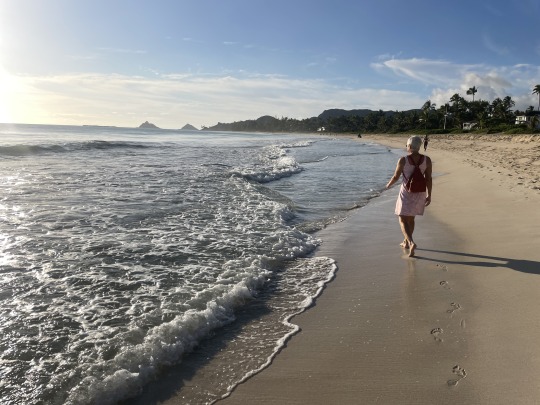
We got roped into dog and bird sitting in Kailua (Ky-lu-ah) Hawaii. So we spent 1 week doing that before extending our adventure to the island of Kauai (Ku-why).

This is Astro “the wonder dog”. A Golden Retriever of squeaky toys.
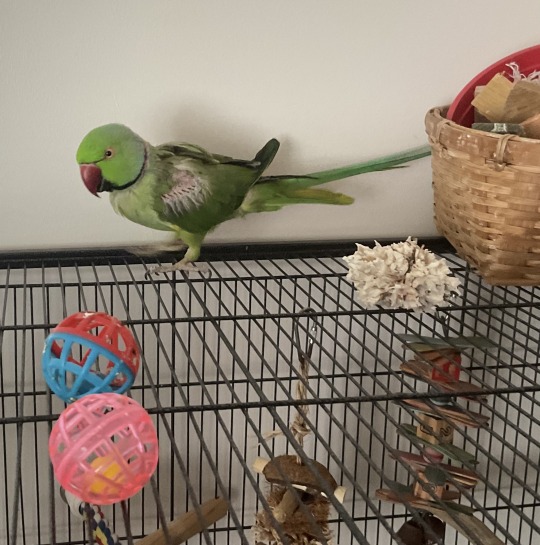
This is Henry who has the run of the house with multiple perches.

This is Mango a rescue bird. The island is over run with Mynah birds. He was found as a fledgling, actually kind of social. The plate is where we put 12 live meal worms every day.
Since we were going to be in the neighborhood, we were drafted to babysit a 5 and a 3 year old. The parents were going to the Submariner Ball in Pearl Harbor on Saturday. They are the grandkids of Bill Cullen who Dana grew up with.
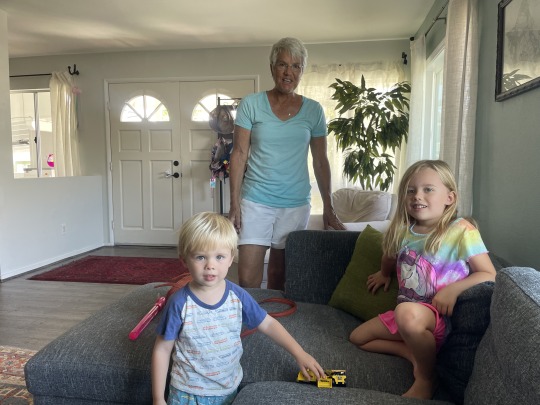
Leo turned 3 the next day. Elizabeth is a real cutie.

We had not seen Chad in 25 years, but he was in town for our first night. He looks, sounds, and laughs like his dad, Bill who Dana grew up with. Laura took Chad, her brother, and us to the local Botanical garden Ho’omaluhia.

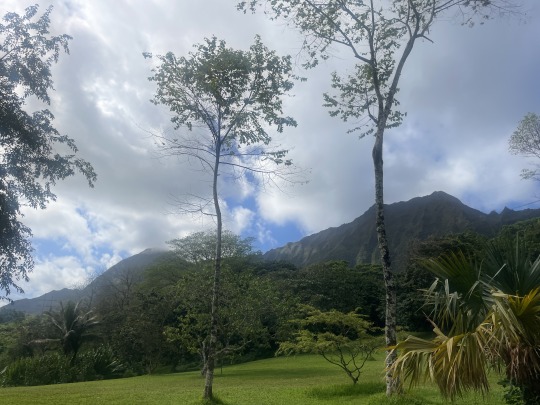
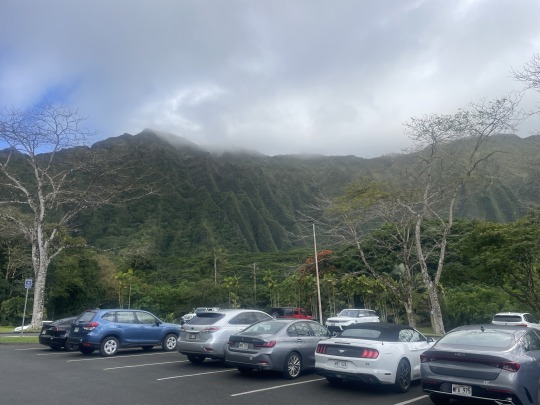
The mountain sides here are extremely steep and lush.

After walking Astro a mile to a “Dog bakery”, we had our first shaved ice. Good but we would have better latter.

It was a long hike so Astro needed some pool time.

Then he wolfed down his specially designed dog treat canollia from the dog bakery.
0 notes
Text
Diving to 2,000 ft. in a homemade sub.

This is “Idabel” designed and built by Karl Stanley, Stanleysubmarines.com
While Lars and I were in a very goofy replica of a sub in the WWII museum in New Orleans. I asked if he wanted to go in a real sub. Without hesitation, he answered “Yes.”
I had heard of this tourist sub years before and it was always on my bucket list. So I searched the internet and found Karl. I emailed Karl and set up a date. He asked if I would bring some mechanical parts in for him, which I agreed to do.

In December of 2013, Lars and I took a day dive to 2,100 ft. in “Idabel.” This was the second sub that Karl had designed and built himself. What is his engineering degree and background you ask? He has a degree in English. But no degree in engineering, physics, metallurgy, or mathematics. Federal law enforcement knocked on his parent's door once trying to figure out what he was up to as a kid.
He was designing his first sub. Which now sits on the bottom of the bay behind his house in West End, Roatan, Honduras.

Stock photo of Karl and his first sub. As far as I know, it did not have any propulsion. Strictly buoyancy controlled.


If you are ever given the choice between going to the moon or diving 2,000 ft. below the surface. Go diving. There is nothing alive on the moon. At the extreme depths of 61 atmospheres (2,000 ft Sea Water), life has evolved into some very unique shapes and adaptations. Here at sea level we deal with 14.7 pounds of pressure per square inch on our body. At 2,000 ft. the pressure is 896 pounds per square inch. Only one percent of visible sunlight reaches to 300 ft. , and that is in the blue spectrum.

Stock photo from Stanley Submarines. This fish is pancake-shaped. Seen from below by a predator against an extremely low light at the lower depths there is no profile to give it away. Typical of fish at these depths are large eyes to take in the minimal amount of sunlight.

This is a tripod fish. They are blind and sit in the sand using their lower tail fin and two pectoral fins to hold position facing into the current. You will see a bunch in the same area all pointing into the current. They are about 6-8 inches long. When its whiskers feel an incoming meal they pounce on it.

This is the “Blunt-nosed sixgilled shark” they grow up to 20 ft. long. Karl in his early days tied hunks of meat on the front of “Idabel” and waited at depth for the sharks to show up. They would grab the meat and shake it furiously to get a bite of it. “Idabel” is only 13 ft. long. How would you like to have two or three of these sharks shaking your sub around like a rag doll?
We did not opt for the “Shark dive”, they are much longer dives. He has a 90% rate of seeing them.

These are crinoids. Fossilized crinoids are found in the bottom of the Grand Canyon, with little change to the crinoids of today. They feed on plankton with their feathery arms. When you watch these just outside the sub-window, their arms are constantly swaying around. The really interesting thing is they can walk. They will walk to the top of a rock to get a better flow of current. It would be like leaving your house in the morning and your sunflowers were on one side of the yard. When you came back home they were on the other side of the yard pointing at the sun. Crinoids can walk 2 ft. an hour.

This is the Giant Isopod. They are the cockroaches of the deep sea, the largest get up to 20 inches. Really wanted to see one but unfortunately did not.

The white curly things are brittle starfish. Having seen the photos before the dive I was shocked at how much constant movement they did. Constantly coiling and uncoiling their arms. I had assumed they were more static.

This red guy is a Squat lobster. They were everywhere. His lobster tail is very small and usually tucked up under the body.
While at 2,000 ft. Lars asked how dark is it here? I am thinking, “Noooooo!”
Yep, all the lights on the sub were switched off. You could hit your face with your hand and never see it coming.

This is an Angler fish. They lay on the bottom and wiggle a small antenna around just in front of its mouth. When an inquisitive fish trys to take the bait. The Angler fish swallows it whole with its huge mouth.


This is a Dumbo octopus, maybe a foot across. Like most octopuses it scoots along by using it's legs and shooting water out of a vent. The unique thing about these octopi is it also has two ear flaps and seem to be swimming by flapping them like “Dumbo the elephant.”


I had asked several technical questions about the sub. Then I asked Karl if he was using Medical Oxygen to supplement the onboard air.
He reluctantly said, “No.”
I said you're not using Aviation Oxygen, are you?
He said, “No.”
You must be using Welding Oxygen then!
He admitted that he was using welding oxygen. Then he asked if I was building my own sub.
0 notes
Text
Tanzania Safari 2024, Part 11.

We spotted this female leopard in a tree before she jumped down and walked to the nearby mawe rocks.



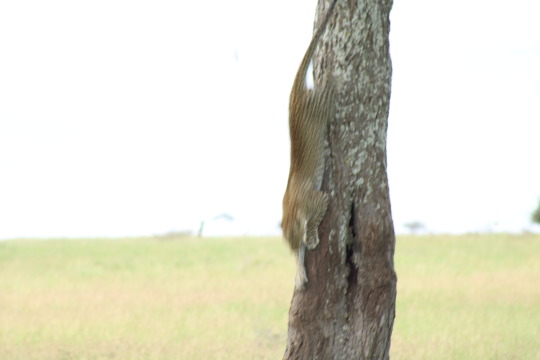

This is a large male leopard in a tree. There are fairly accurate counts of lions in Tanzania but not leopards. They are just so elusive we have been fortunate to have spotted at least 6.

A little hard to tell by the photo. We were always on the look out for a dangling leopard tail or maybe a leg. This caught my eye. It turned out to be a leopard's lunch leftover. You can see the hoof of a gazelle angling down and to the left.

This is a greedy hyena eating the last of a gazelle leg. A second hyena wanted it but was not brave enough to fight for it.

This is a Hartebeest, so named because the shape of the horns resembles a heart shape.

This is a closer look. Note the coloration inside of the ears and how high the eyes are on the head. By having eyes that far up they can see what predators might be stalking them. While they have their head down feeding. Pretty sure it was the basis for one of the creatures in the Star Wars bar scene.


This is the Servel. They only weigh up to 40 pounds. This one seemed to be calling and looking for its kittens. There are white patches on the back of its ears that the kittens can keep track of while mom is walking ahead in the grass.

Roads here were a quagmire. Raffy stopped to help this jeep get unstuck. There was an armed ranger (on the right) standing by for protection.


Raffy got out of our jeep and checked for any predators. Once he was satisfied that nothing would harm us. He had us stand on the road while he pulled the other jeep out. Seeing a small termite mound near me, I bent over and looked down in it. I could see 50 or so termites walking around on the inside. After we got back in the jeep, I mentioned it was pretty cool looking down the termite mound. Raffy almost turned white. He had forgotten to tell us not to go near termite mounds. Black Mamba snakes live in them and will shoot straight up out of them.


Raffy saves the day again by pushing another jeep that was stuck in the mud. He drives through these mud holes in third gear. You could tell when things were getting serious because he would shift into second. First gear was reserved for emergencies only.


Here we are having some sundowners prior to returning to camp. Raffy was not drinking, just the rest of us.
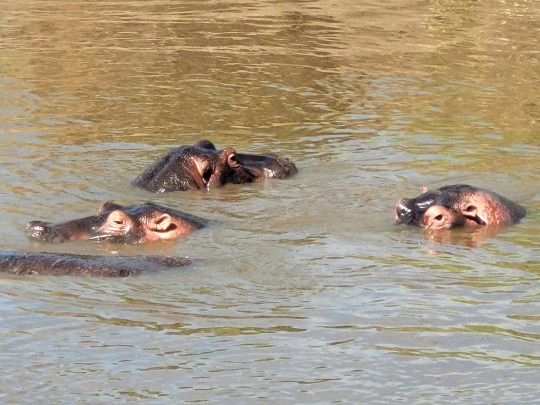

Hippos in the river.

This is a Nile monitor, they can grow up to 6 feet long. And are Africa's largest lizard. We only saw two during or travels. Notice the forked tongue.


Nancy and I got delivered to a small dirt strip, Seronera, and flew back to Arusha in a Cessna Caravan. Heards of gazelle and wildebeest were grazing beside the runway, which did not really have any kind of fence around it. The pilot did not seem to be concerned.

This is looking out the aircraft window at a bunch of young male Thompson Gazelle standing next to the runway.
If you are interested in your own African Safari, please check out Raffy at: https://maweafricanventure.com
0 notes
Text
Tanzania Safari 2024, Part 10.
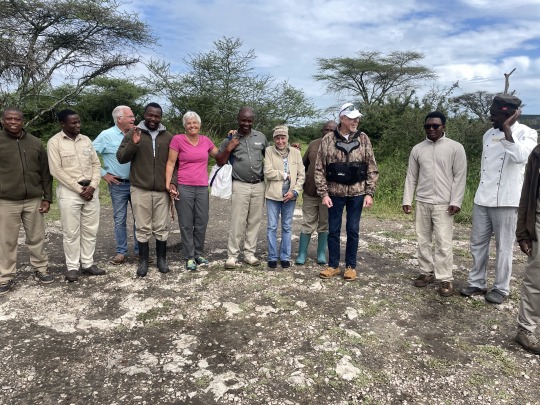
Sadly we leave Lamala Ndutu camp today, everyone showed up to say goodbye even Chef Chris on the far right.


Dana checking out the knife our evening guards carry. As we load up into the jeep, the staff breaks out into the “Jumbo Bawana” song. Really going to miss this camp and it’s staff.

Look at these beauties. These are Marabou Storks they can reach almost 5 feet tall.

Here are two young male Impalas practicing fighting for the day they get to rule a harem. These are very abundant animals, when you see them from the rear the black lines on their rump and tail resemble an “M.” They are known to hunters as the “McDonalds of the bush.” Guess they make tasty burgers.
The black marks above their ankle is their musk glands for marking their territory. Notice how so many things here mark their territory?

This is a mating pair of Fischer’s love birds. They mate for life. Their bond is so strong that if they become separated the health of each bird suffers. They are only found in Tanzania.
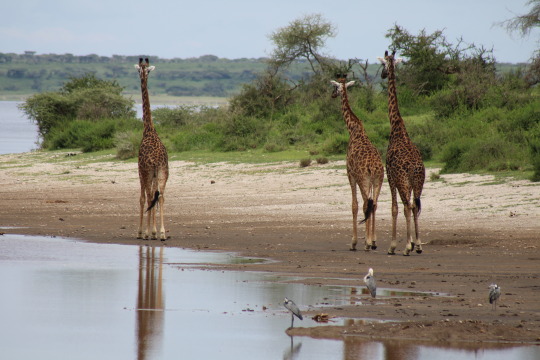
Three giraffe at Lake Ndutu.

Raffy with us at the official gate to the Serengeti. We travel 18 klicks through the low savanna to the park headquarters for lunch. The road to the headquarters is dirt and in pretty good condition. The speed limit is 50 Kilometers per hour.

Disposable box lunches were provided by the Lamala Ndutu camp. The lunch boxes were a work of art made out of banana leaves. They always give us more than we can eat. So we pack any leftovers into a single box for some local person who would appreciate a “free lunch.”
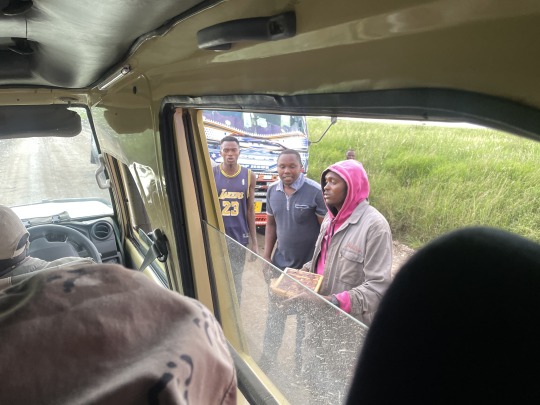

Good thing we did. It had rained the night before and roads in the park were one muddy mess. We came upon these three guys who had not eaten in 3 days. Their truck was buried up above its axles for two weeks.
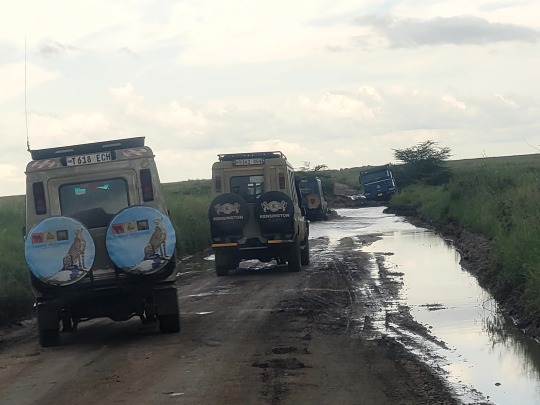


We had been driving every day for five days and needed fuel. This was the only gas station we saw after leaving the last paved road, five days ago. Guess what, they were out of fuel. Maybe a delivery tomorrow.
Raffy seems to know everyone. One phone call and twenty minutes later, he is getting about 20 gallons delivered from some camp's stock for their generator.

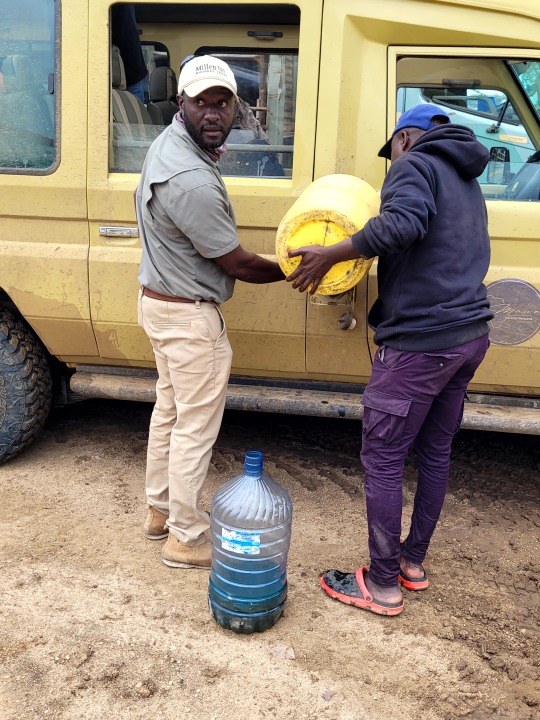
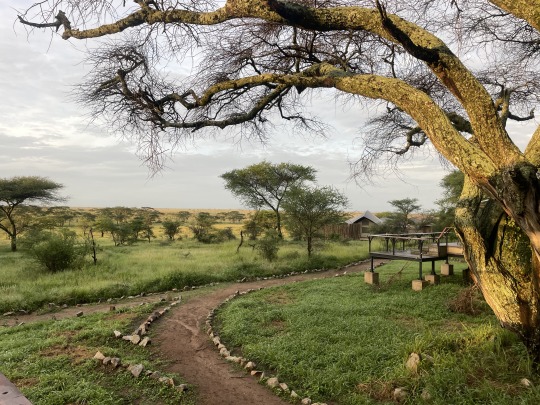

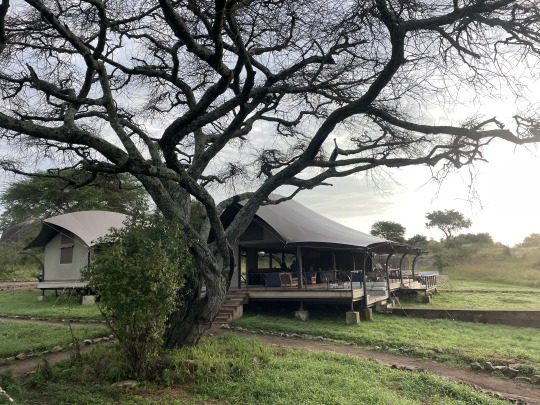
We get to our new camp, Lamala Serena, close to sunset. John is the manager, he welcomes us with the rules, layout, and eating times. While he is talking I spot a troop of Baboons crossing the savanna behind him. This is an absolutely beautiful camp tucked up into the mawe rocks. Rocks here are a favorite place for big cats to hang out. The rule here is we are not allowed to walk at ANY TIME without an armed Maasai escort.
We have a phone in our room to call for an escort. Just dial 444.
I think it should be 1-800-call-Maasai.





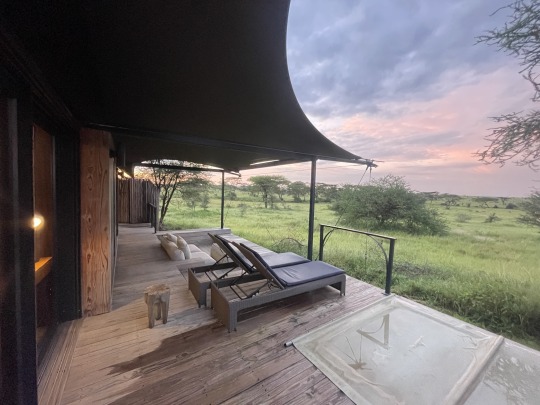
This is a permanent camp and the buildings are part tent part building. Large sliding glass doors to the deck that has a miniature pool, and several lounge chairs to view the wildlife walking by.
Water pressure made the indoor and outdoor showers a real treat.
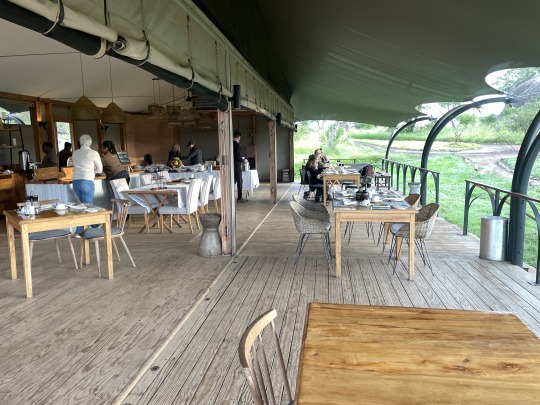

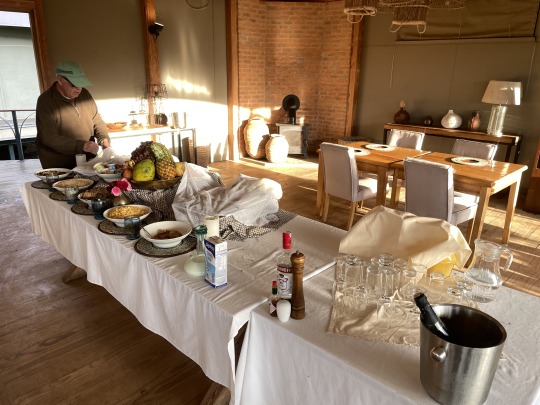
We were really surprised to find two “bush babies” in our bed, after returning from dinner.


A “bush baby” is a hot water bottle. Above Dana getting an escort from a Maasai warrior. Notice Dana is staying real close to the guy with a spear!
0 notes
Text
Tanzania Safari 2024, Part 9.

Once again we are the first jeep out of camp enjoying a beautiful sunrise.


We check in with the mother lion and her three cubs.

Then we check on the pride staying a mile away.
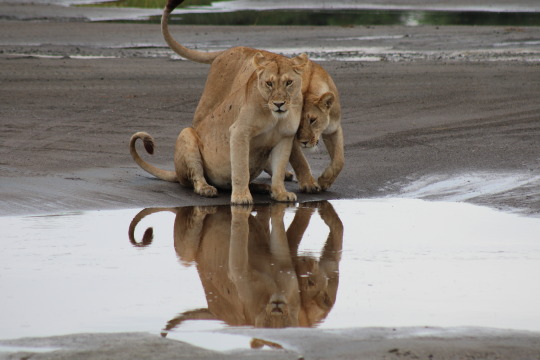
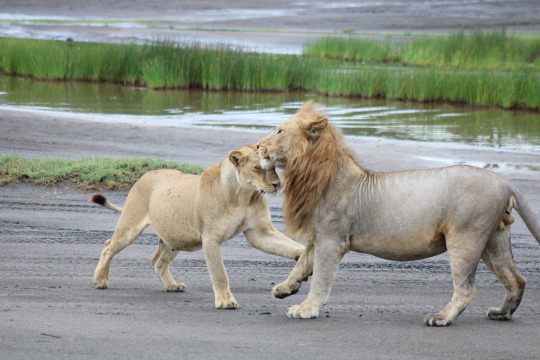
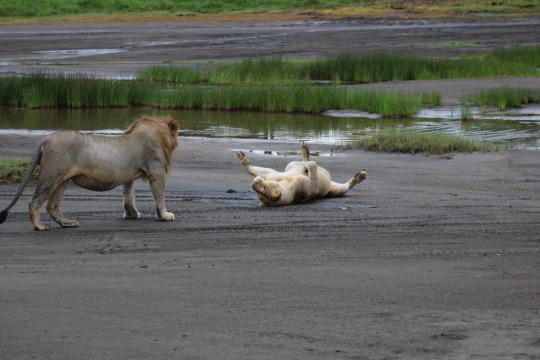

This is a Kori Bustard which is the largest flying bird in Africa. Its wing span can be 7-9 feet across. This may be the largest bird in the world capable of flying.

This is a very full “duma” (cheetah) after feasting on a fresh wildebeest.

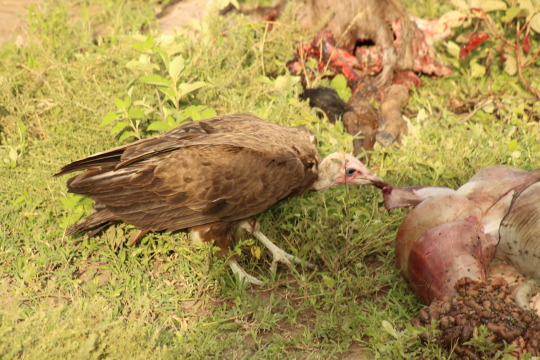
While the cheetah is taking a breather between courses, the vultures move in.

She moves back to the kill, running off the vultures.

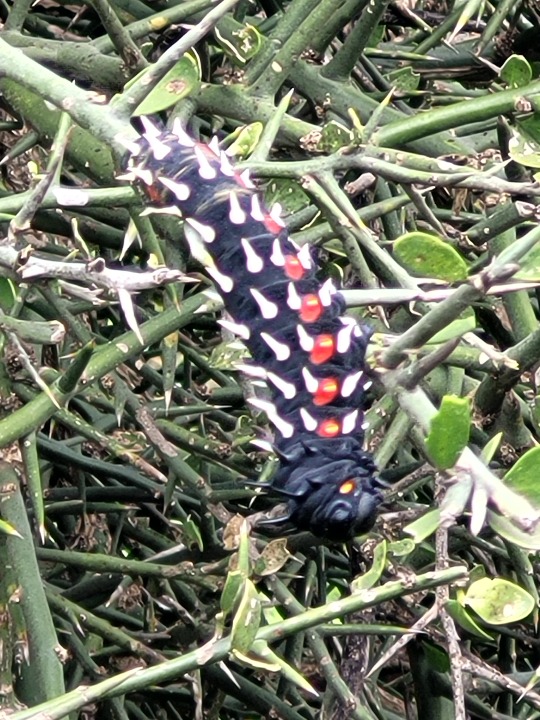
This caterpillar is a little bigger than your finger. Looking at those spines and bright red spots, I would leave it along. This Acacia was full of them. This was the only tree we found with them.

This is a male Dung beetle rolling a ball of dung back to its hole. The male stands on his head pushing the dung ball with his back feet. If his mate was around she would be standing on the top supervising.

This “chui” (leopard) has either two or three kittens hiding in the grass. We watched as she retrieved one kitten in her mouth and took it back to a hiding spot. She huffed at us letting us know she was upset with us.
In the Ndutu Conservation Area, the guides are allowed to drive anywhere they want and do not have to stay on the roads like in the parks. We never would have seen this leopard otherwise.

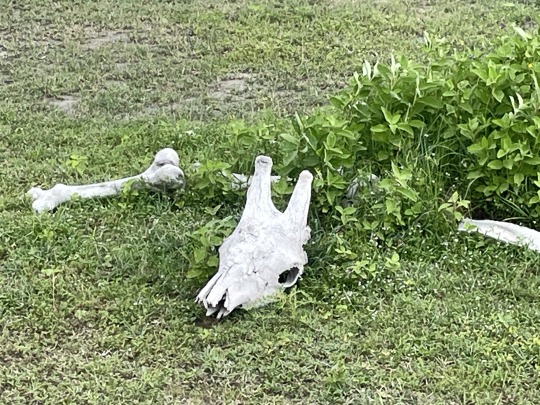

This is a giraffe skeleton, duh! But it is laid out so well, that I believe some guide rearranged the bones.


Back at camp, the photo on the left is the bar. The drawers on the right are where you charge your electronic devices. Your drawer is the same as your tent number.

This is a local liqueur Amarula which is made out of the seeds of the Marula tree otherwise known as the “Elephant tree.” Tasted much like Baileys Creme liqueur.
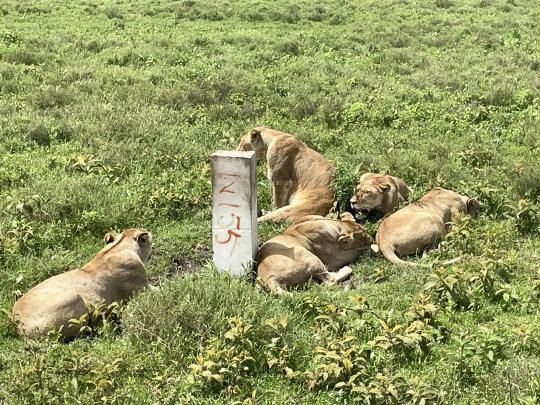
The concrete post in the photo marks the line between the Serengeti Park and the Nduto Conservation Area. Apparently, the lions loved rubbing on it and laying in the shadow.

You can see where animals frequently rub on the marker.

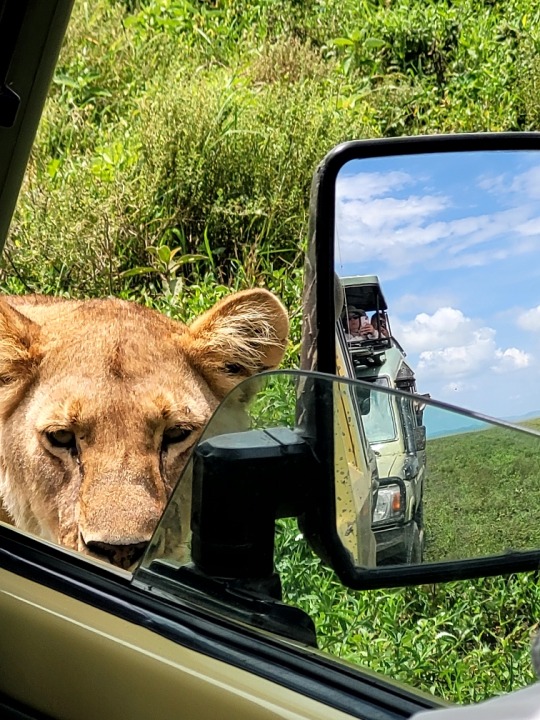
When any of the big cats that are lying around do a big yawn. Get the cameras ready, something is about to happen. This girl yawned and then walked over, just about putting her chin on the jeep. She looked right in our window and then casually walked around the front of the jeep to do a “tire pressure check.”

0 notes
Text
Tanzania Safari 2024, Part 8.

How many ways can a big cat sleep in a tree?

Lions sleep about 15-18 hours a day and mainly hunt at night.


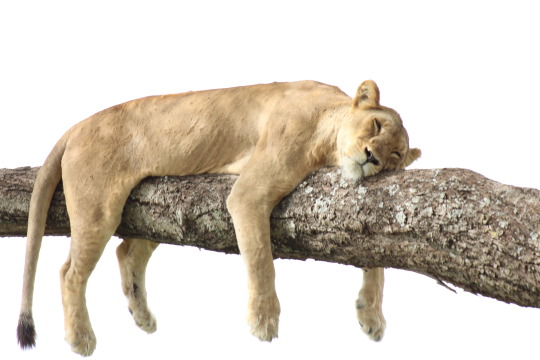


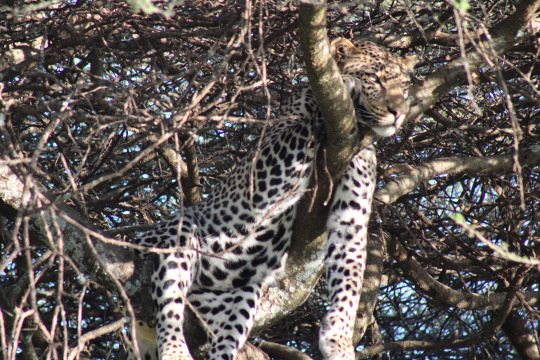
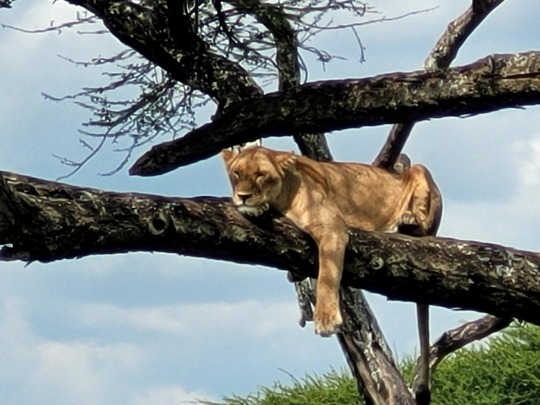
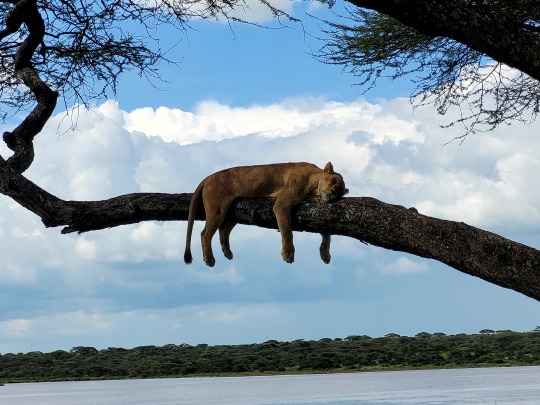
1 note
·
View note
Text
Tanzania Safari 2024, Part 7.

Here is “Simba” and crew looking for wild animals. Binoculars and cameras with telephoto lenses searching far and wide for lions, leopards, cheetahs, warthogs, and other dangerous animals.
While I stand out in the open taking the photo!

This is a dik-dik. They are very small antelope only standing about 15” at the shoulder. They mate for life and tend to be very seclusive. The black patch below the eye is a gland that they use to mark their territory.
Note the large eyes, these are mainly nocturnal feeders.
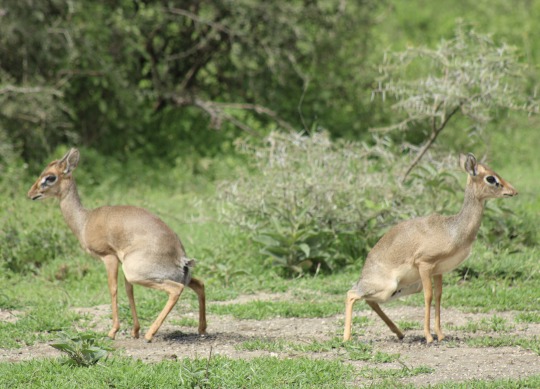
Amazing how smart the dik-diks are. They only defecate in the exact same spot so they do not leave a scent all around for a predator to smell.
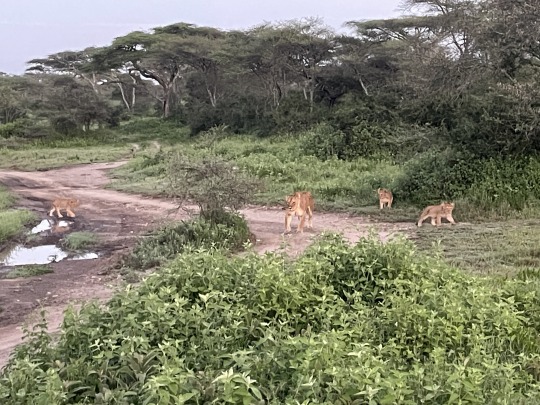
Leaving the camp very early we spied a mom with three cubs. We would check in with her each morning and just before we would return to the camp. Fun watching the cubs play attack each other.



Early morning light is horrible for taking photos.
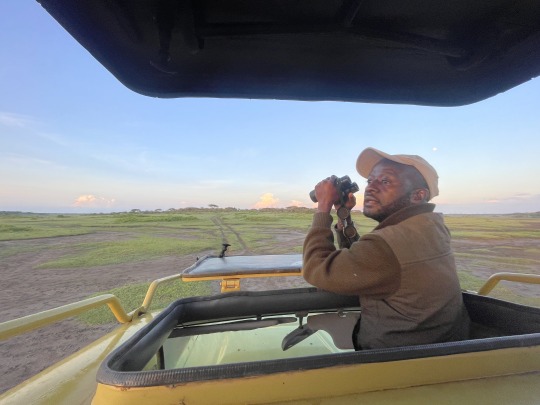

Raffy would be driving from his lower perch. While picking his way through the best path in the mud and trying to avoid any “shimos” (holes). He would suddenly stop and pull out his binoculars. He could spy an animal a mile away while driving.


A large male leopard was hanging out in a tree and would be surrounded all day by up to 20 jeeps. Luckily most of his hunting was done after 6:30 pm when jeeps were not allowed to be out of camp.

This was his meal from the night before, an entire wildebeest. Note the cloven hoof at the bottom right of the photo. How a leopard can drag a large ungainly carcass up a tree is amazing. Apparently, they eat the organs first to lessen the weight and gain some energy. Then they drag the rest up the tree before any other predators try to steal some.

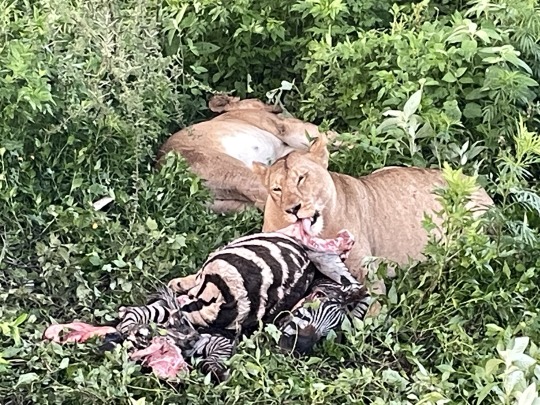
Here are three female lions working on the last of their zebra breakfast. The lions have huge swollen stomachs from all that they have eaten. It will be a lazy day for them today.
Once again a vegetarian didn't fare so well during the night.

The young lady on the left is wearing the latest in Safari jewelry. A very nice tracking collar.
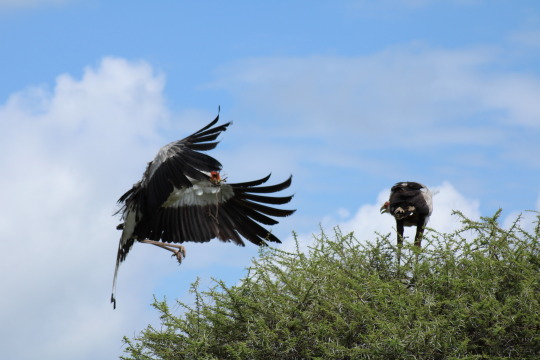


Here is a nesting pair of secretary birds. They have the body of an eagle on crane-like legs. They are huge birds standing over 4 ft. tall. We watched this male drop off the Acadia tree hunting around for sticks. Once he found what he wanted he walked about 50 ft. downwind of the tree. Then took off into the wind to deliver his prize to his wife.
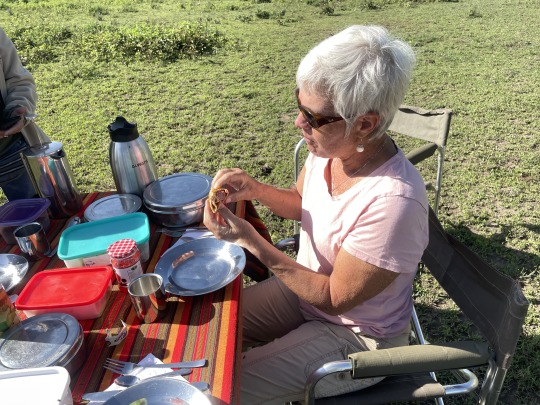

Another late breakfast provided by the lodge on the open savanna. After each of us did a quick “tire pressure check.” We were off on the hunt.

We found a mother “Duma” (Cheetah) with three young cubs. She was watching a mother gazelle deliver a baby. When the time was right she stalked over to the pair. Leaving her young hidden in the grass.

The mom stalked as close as she dared then raced to the newborn. The mother gazelle took off trying to lure the “duma” away. But the mother cheetah was no fool, she called her cubs over to the newborn gazelle. They toyed with the baby just like any cat would play with a mouse. The mother patiently sat back and watched her three cubs chase the baby around. The baby gazelle was bleating for its mom who stood a hundred yards away. Watching as the newborn stood on wobbling legs.


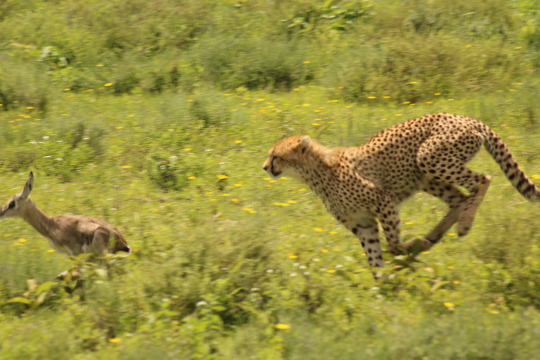
Outnumbered the gazelle did a great job of running here and there. The cheetah cubs would play tag with it, only trying to trip it up. Once it would lay down they would gingerly paw at it. Then it would take off again and the chase was on. Mother Duma watching all the time with a bored look. The mother gazelle had to hear its baby bleating for her. Several times we thought the baby gazelle had been killed. But it would pop up and run some more. Finally, it was put out of its misery.
This is what Ruth had come to see for her 30th trip to Africa, a cheetah chase and kill. Not quite the large animal kill she wanted to witness. But still such an epic scene of life and death on the Savannah. We had witnessed the entire short 45 minutes of life of this baby gazelle. Cheetahs hunt during the day, which is the only time we are allowed to drive around in the park. When we are confined to camo at night is when the Lions do their hunting.

After the first night of dining with everyone else at the camp, we got moved from the far end of the very long table to the near end. I guess the liberals next to us requested that we be moved. Not really a problem for us.
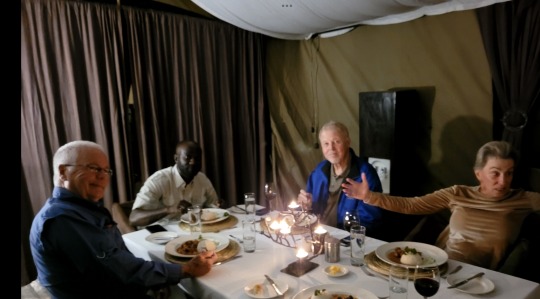
Unfortunately, we were then seated next to a couple new to the camp who were vegetarians from California. Ruth went into great detail about the baby gazelle being killed and eaten that day. Poor ladies almost lost their appetite.

The next night the staff only had one option left, and that was to separate us heathens from the rest of the nearby tables.
Worked for us!

Nancy talking to the staff in the main tent.

Nancy checked out Chef Chris’s kitchen. His kitchen was cleaner than most restaurants in America.
0 notes
Text
Tanzania Safari 2024, Part 6.
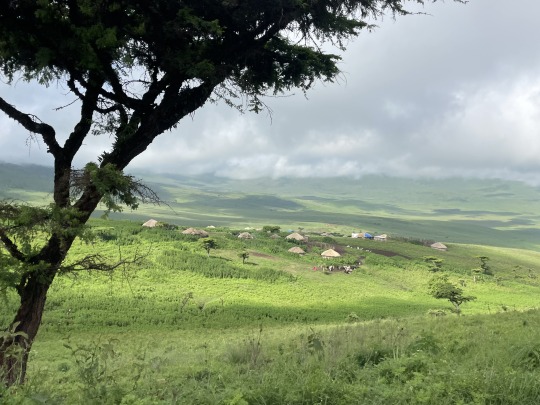
Leaving Ngorongoro Crater Park, we travel west past many Maasai villages. The Maasai are a herding tribe, whose life revolves around cows and goats. The huts you see are made of sticks and cow dung. Each village will have a protective corral lined on the outside with thorny acacia branches to keep lions out. Maasai warriors will take on a lion using only a spear to protect a cow.
In the early days, a Maasai boy who wanted to become a warrior had to kill a lion with his spear. That is now outlawed, but Lions respect anyone wearing the traditional red and yellow wrap the Maasai wear.

We did a quick restroom break at the monument to Earliest Man. The Olduvai Gorge is considered the “cradle of humankind.” Dr. Leaky and his wife found evidence of two hominin species of man dating back 1.84 million years.
Small world, our travel companion Ruth, casually mentioned that she had met Dr. Leaky once.
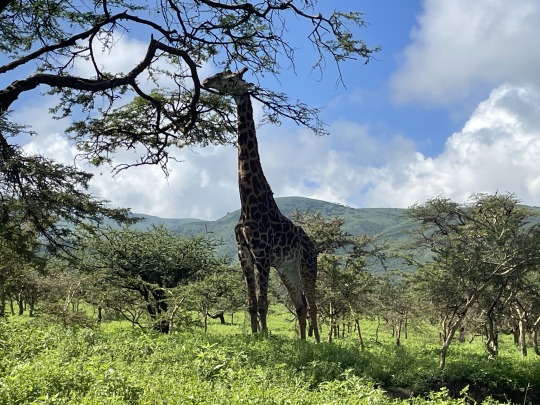
It's scenes like this when one of us would say, “This kind of makes me think I am in Africa.” Such iconic scenery, that we could not help it.
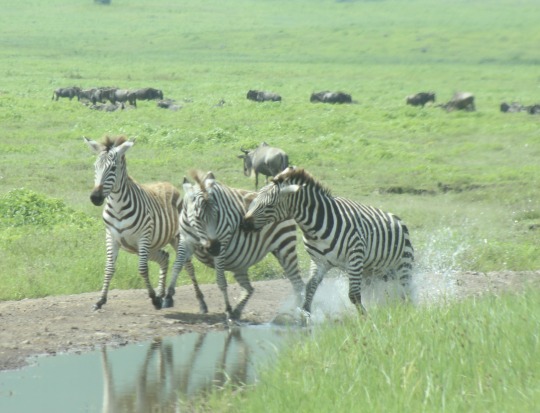
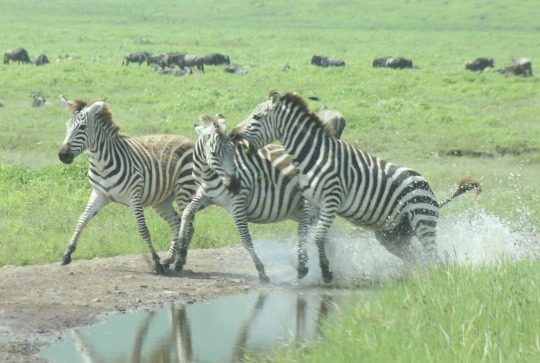
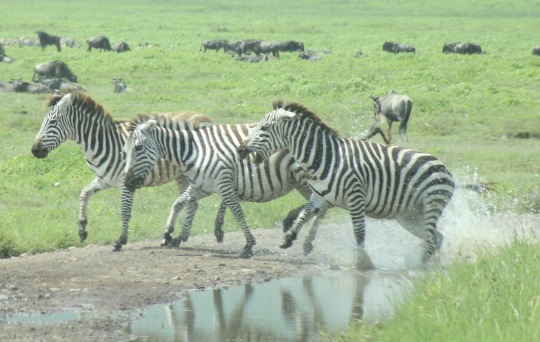

Another zebra wanted a piggyback ride but the ride was closed.

Lake Manyara Park promotes itself as having the only tree-climbing lions. Not so, this girl was in the Ndutu Conservation Area. The lake in the background is Lake Ndutu.

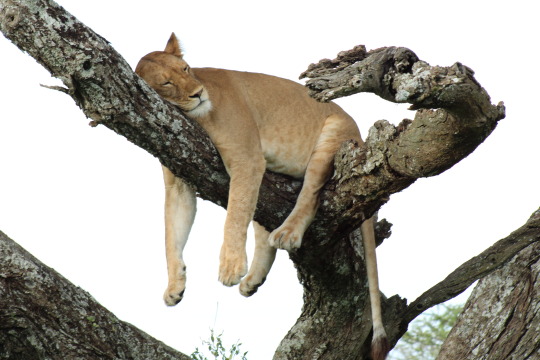
After finding these girls lounging around with full bellies. We went to our camp. The Lamala Ndutu mobile tent camp was probably our favorite camp for several reasons. Not as fancy as the Lamala camp in the Serengeti we will stay at later. But this really gave us the feeling of being a part of the early safari history. I was waiting for Dr. Livingston to walk in, followed by his porters.

This is Ruth coming into camp, she becomes affectedly called “Bibi”, which is Swahili for Grandmother. She was treated in camp as though she was the actual grandmother of each of the staff.

This is the main camp and dining area.

Here is the camp manager, Kasiga (on the left), as we are welcomed with fresh juice.

Each time you come to a new camp the camp manager welcomes you and explains the camp rules, layout, and eating times. At this Ndutu camp, we can travel without escort to or from our tent ONLY during the daytime. After dark we have to use the VHF radio in our room to call for our Maasai escort.
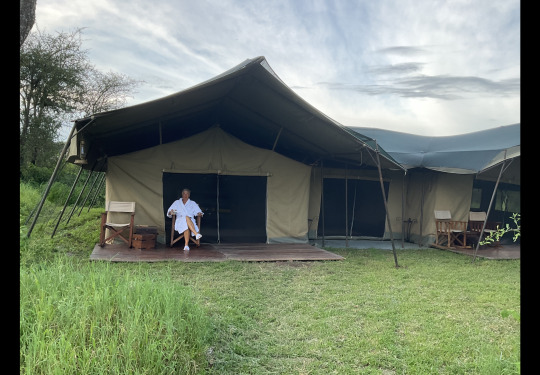
We have tent 5 which has two bedrooms, separated by a common area with a couch. Here Nancy is relaxing with a glass of wine in her bathrobe on the front porch. As a young giraffe walked around the edge of the camp.

One of the Maasai nighttime escorts is helping to get the evening fire going for the guests. Did you see the young giraffe on the right side of the photo? Animals just wander through camp. We are warned to keep our eyes open and head on a swivel when walking to and from our tent. At this camp with the thin canvas walls, we would hear lions call all night.
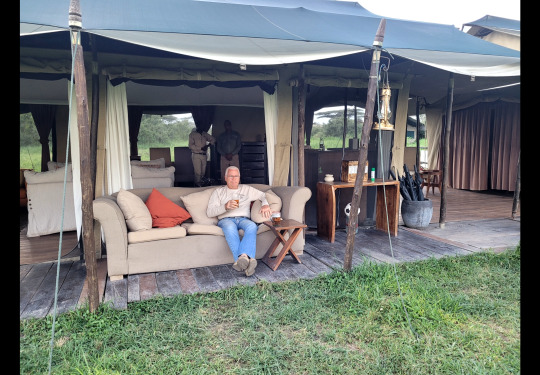

Hanging out at the main tent, while the outdoor fire is getting started.



This is our bedroom and bathroom. When we get back to the camp each evening, we arrange for our “talking shower.”


After coming back to camp after a dusty ride in the bush. We arrange to take a “talking shower” in 15 minutes. When you are ready for the shower. You “tell” the staff who is just on the other side of the tent wall. Then he puts hot water in a canvas bag and then hauls it up by rope and pully. Which provides enough head pressure for the shower. Once the staff has raised the bag up, he “tells” you it is ready. You simply pull down on the wooden toggle to turn on the shower then pull the opposite toggle to turn it off. No choice in temperature, just ON or OFF.


This is the dining room during lunch. Raffy eats many meals with us, which gives us a chance to learn more about him and his culture.

The first night's dinner was well attended. A birthday cake was brought out. Then the staff broke into the typical “Jambo Bwana” song. Clapping and singing in Swahili. Raffy interpreted the song for us. It is a song where the staff basically tell their guest, “Hello…no worries….all are welcome.”



At first, Nancy and Ruth were content with clapping in rhythm with the song while seated. But then they got up and joined in the conga line.
Below is the original song from 1982 in Swahili, by “Them mushrooms” from Kenya:
Jambo, jambo Bwana (Hello, hello Sir)
Habari gani (How are you?)
Mzuri sana (Very fine)
Wageni, mwakaribishwa (Foreigners, you’re welcome)
Kenya yetu, hakuna matata (Our Kenya has no problems)
Kenya nchi nzuri, hakuna matata (Kenya is a nice country, there are no problems)
Nchi ya maajabu, hakuna matata (Country of wonder, there are no problems)
Nchi yenye amani, hakuna matata (Country of peace, there are no problems)
Watu wote, hakuna matata (Everybody, there are no problems)
Wakaribishwa, hakuna matata (All are welcome, there are no problems)
Hakuna matata, hakuna matata (There are no problems, there are no problems)
1 note
·
View note
Text
Tanzania Safari 2024, Part 5.

Typical behavior of zebras standing around resting their heads on each other. If you look closely you will see two yellow-billed oxpickers standing on the zebras. They do pick off a hundred ticks a day, but also open up scabs and drink the animals blood.


Breakfast is provided by the lodge, and eaten at the picnic site down in the crater.
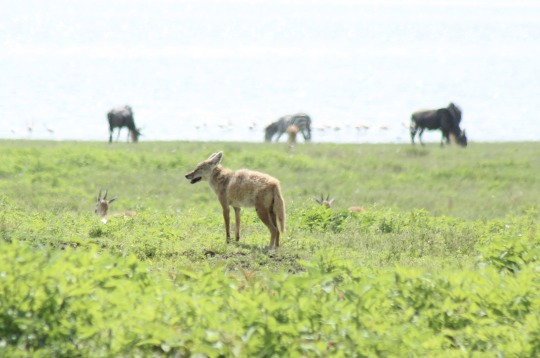
This is the only African wolf we saw during our journey.


This bird is the Hamerkop, so named because the crest of its head resembles a hammer. These birds are unique because of the huge nests they build measuring up to 5 ft. wide. Building a huge nest is so ingrained in their DNA that they build 3 to 4 nests during the year whether or not they are breeding. It takes on average 8,000 sticks and pieces of grass to make a nest.
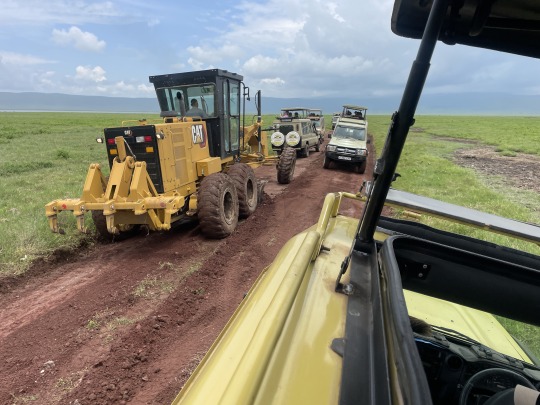

The roads are constantly being graded and are in great shape compared to what we would travel on in the Serengeti.


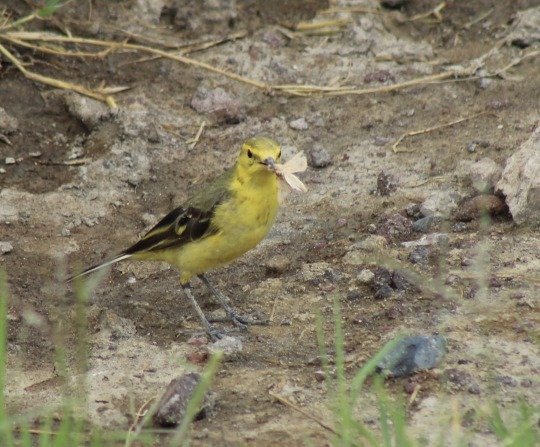





Here are two zebras cavorting.


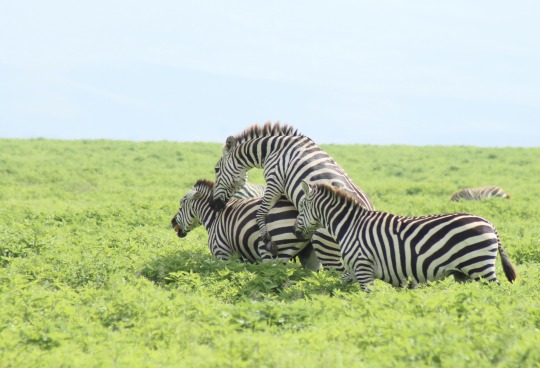
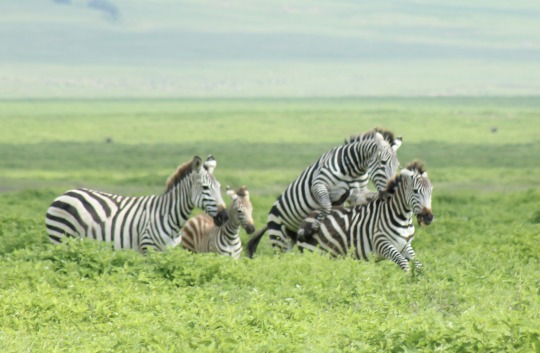
Piggy back rides always gathers spectators.
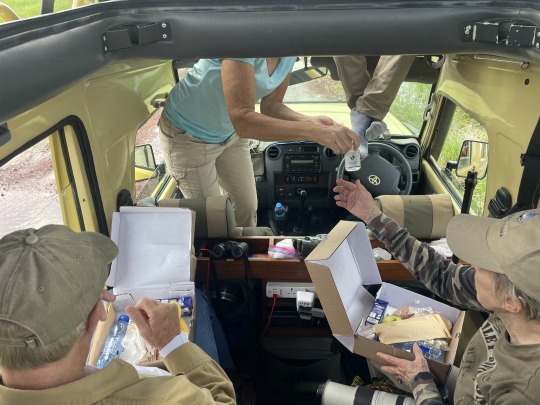


Lunch break with box lunchs provided by the lodge.

This is as close as we got to the black rhinos. Here are two moms and their two young. With one single rhino by itself. We had watched a helicopter circling low in the valley. Apparently, the park service darted a black rhino for its yearly medical evaluation.



Restroom break back at the public picnic site.
1 note
·
View note
Text
Tanzania Safari 2024, Part 4.

After a quick breakfast at the lodge, we will drop down into the volcanic crater where we will see black rhinos, lions, elephants flamingos and our first hippos.








The lodge was great and the food was excellent. Our waiter for each meal was Bonafort. He lives here for two months at a time before seeing his family who live 6 hours away. The handwritten note shows how much the Tanzania people want to please their guests and hope they come back.

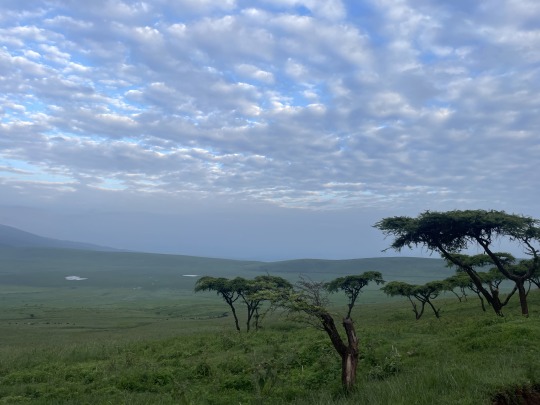
Entering here at the manned inbound gate and dropping down the one-way road into the crater. Down in the crater will be the only place we see the Black Rhino during our travels. The rhino is much sought after by poachers for their horn. These rangers are deadly serious about protecting the rhinos and elephants. Apparently, the rangers are very proficient at catching poachers. Strangely they never bring them back for prosecution.
Damn, hyenas can smell a dead carcass buried underground and occasionally dig them up.


Our first lion was sacked out after eating a huge meal. Lions sleep about about 18 hours a day. Well, really just “Cat nap.” Once a lion is found near a road, all the jeeps show up causing a “lion traffic jam.”




This is a just-born white beard Wildebeest. This time of the year is known as the calving season.
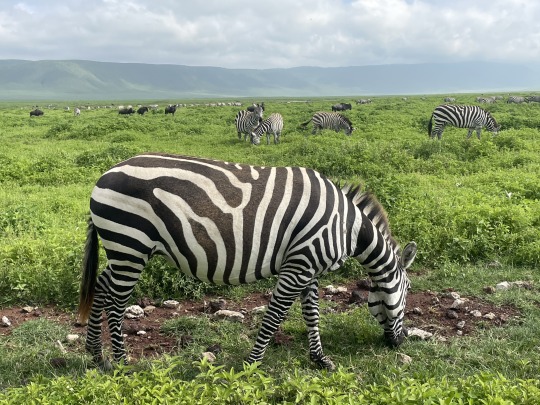
This zebra looks like she is due to deliver at any time.


The warthog on the left is a male, which is determined by the prominent wattel protruding just below the eye. The large wattel on the male is useful as protection when fighting other males during fights over the females. The female on the right has wattels just not as big. Since the females don’t head butt each other like the males, they don’t need large wattels.
The upper tusk, which is attached to the upper jaw, can grow to 10 inches. The lower tusk, which is attached to the lower jaw, constantly sharpens itself each time the mouth is opened and closed.
0 notes
Text
Tanzania Safari 2024, part 3.

Nancy had brought some school supplies and small toys for the kids. On the way to Manyara Park, Raffy saw a group of kids and their teacher under a tree playing games. We pulled in and Raffy talked to the teacher explaining why we stopped. She invited us into their one-room schoolhouse. Above the kids all wanted to hold my hand as we walked to their schoolroom. Those who could not get hold of one of my fingers. Did the next best thing and held the arm of a classmate who was holding my finger.
Each school has their own uniforms. Education is a critical part of the future, and the parents know it. All of these kids were excited and engaged. Sitting at a small table designed for maybe three kids. Were five kids jammed shoulder to shoulder with the outer two kids barely having a bench to sit on.


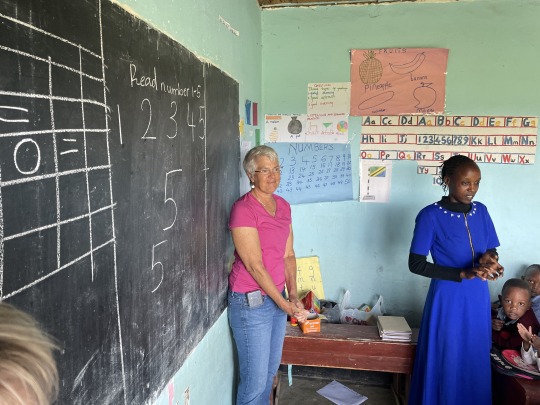
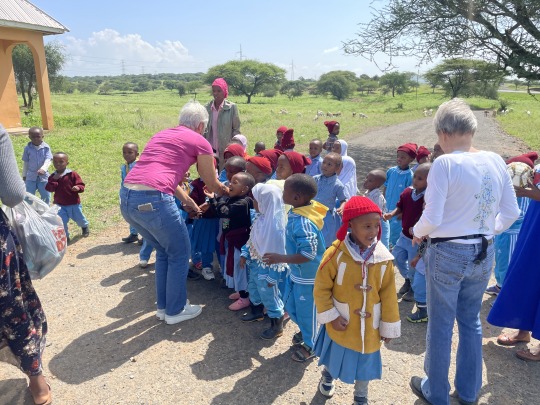
This is a private school with about 50 students. Public schools don't have buses. Only the very affluent private schools do. It was very common to see very young kids, miles from the nearest building or paved road, walking in groups of two or three. One young kid would be carrying a full-size machete for protection from wild animals.


Tanzania is coming up on an election year, so here are a couple of street rallies. Currently, Tanzania has its first female President. I believe Green is the symbol of this political party.
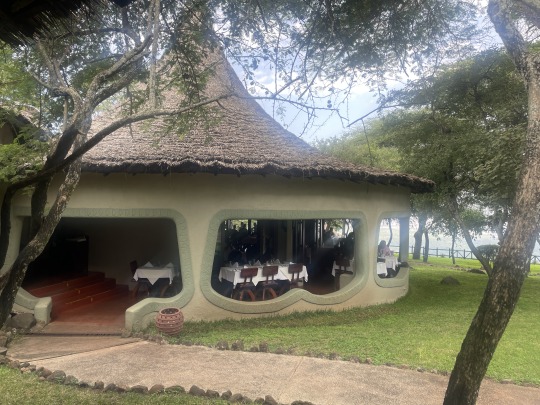



We drove up to the top of the ridge overlooking the rift valley. There we had a beautiful lunch with a great view at the Lake Manyara Serena Lodge built in 1996. Then back down the winding road to enter the oldest park in Tanzania, Lake Manyara National Park.
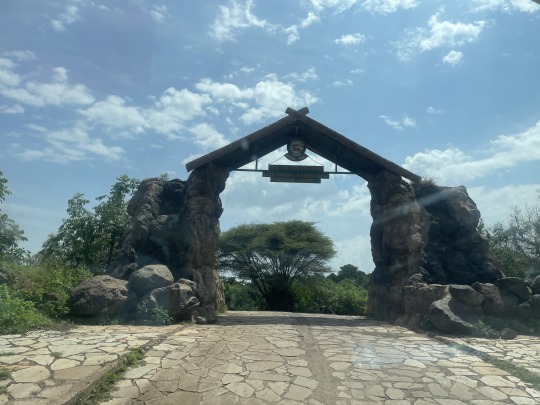

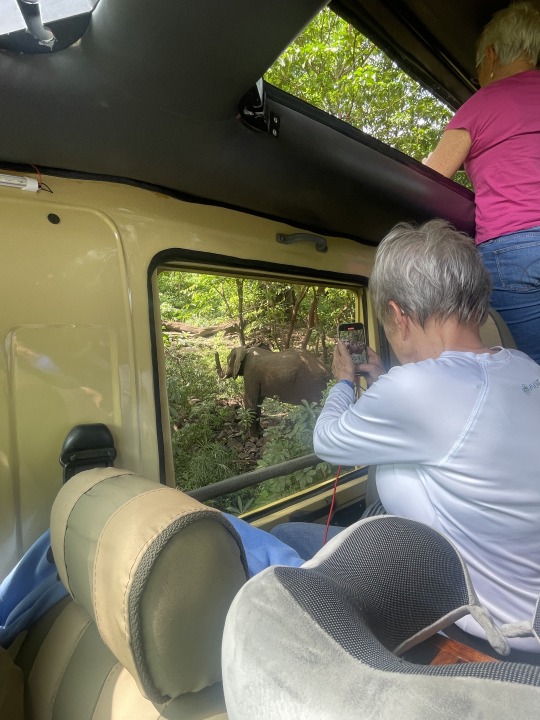
We barely get in the entrance and start seeing baboons and an elephant. Here as in Arusha National Park, we are required to stay on the main roads which are dirt. The road travels mostly through wooded areas opening up at the southern end of the park into more open views. I saw my first of two Nile monitor lizards at a water crossing. On the last day of the safari, I was able to photograph the other one.
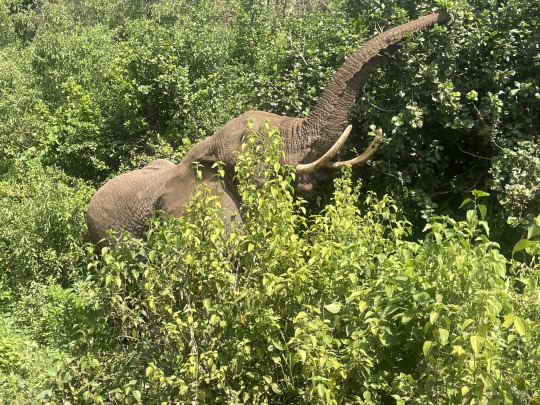
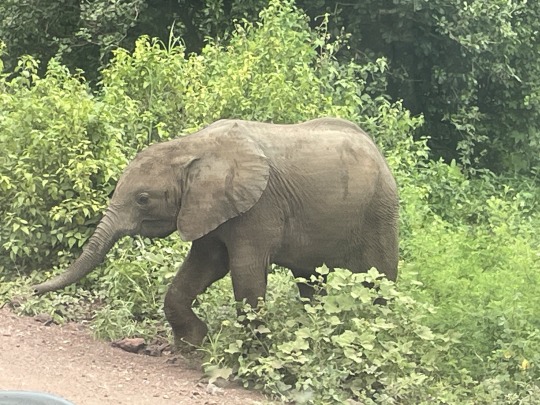


Here are two Baobab trees. The one on the left is a male, and the one on the right is a female. Limbs for the male droop down whereas the females reach up. The baobab trees live as long as 2,500 years. The larger trees hold up to 36,000 gallons of water to survive the droughts. The inside of the tree trunk is spongy like the inside of a cactus.


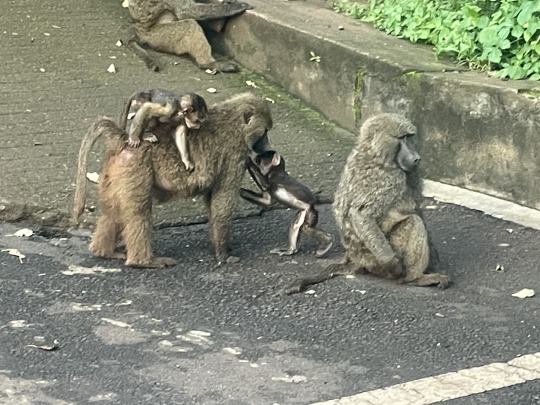

This troop of baboons and their babies kept us entertained while Raffy went into the headquarters at the Lagoro entrance for Ngorongoro Crater National Park.







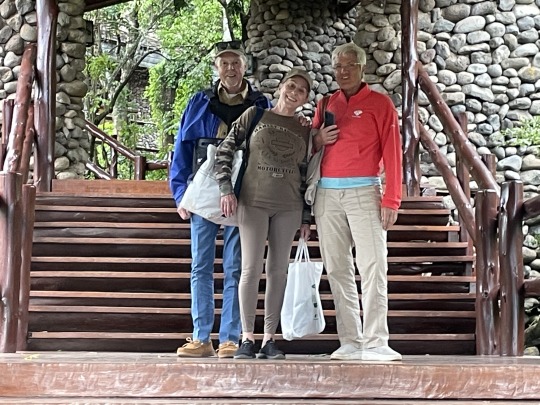
This was another beautiful lodge we stayed in. Typically when you arrive at the lodge or camp you are met by several guys to unload the luggage and one person with a tray of scented warm hand towels. Very refreshing after a dusty ride in the open-air jeep. This lodge was huge and reminded us of the lodges in the old US western parks like the “Old Faithful” lodge. Being at an altitude of 7,546 ft. we got winded walking the many steps back to the lobby.
After a great dinner in the main dining hall, we retired to our room overlooking the crater with a full moon illuminating everything.
This ends day 3 of our time in Tanzania.
0 notes
Text
Tanzania Safari part 2
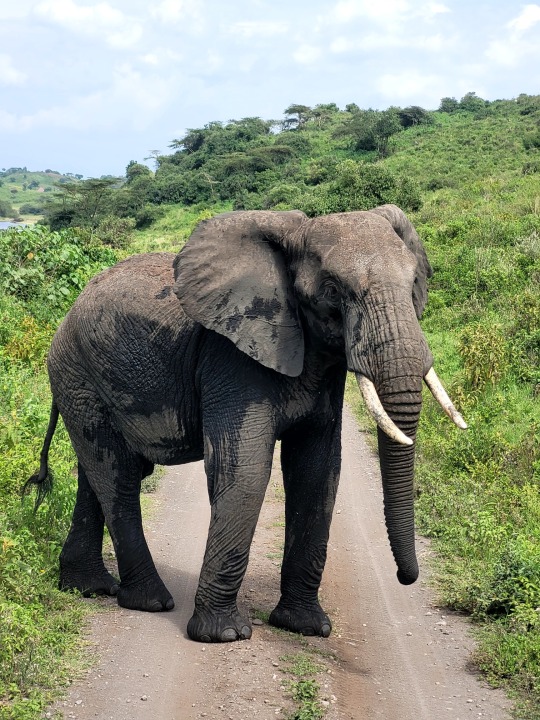
This old guy looks like he is “right-handed.” Elephants will be left-handed or right-handed like humans. The way you tell is which tusk is more beat up and ground down from them using it predominantly to root things out of the ground. This guy is not so obvious but others we saw were.
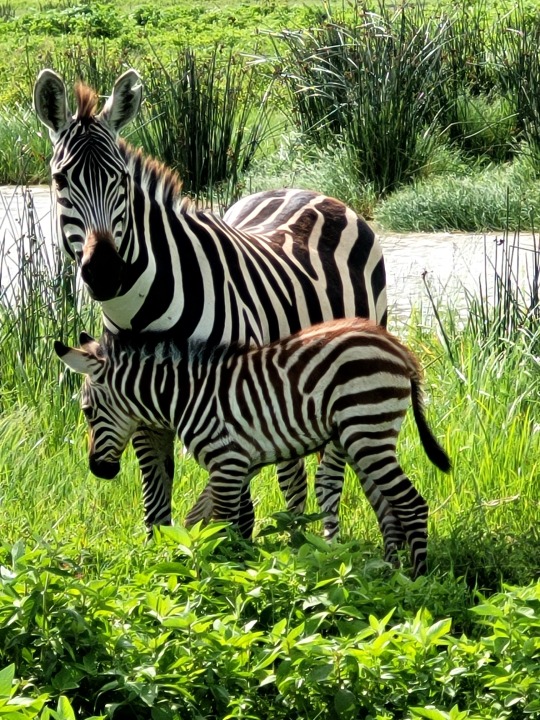
Here is a young zebra with his mother. The young will have more of a brown mane. The Americans say “Z-bra”, the English say “Zeb-ra.”

Nothing like a little attention to detail. Two adult Blue Monkeys.


More Blue monkeys. The monkey on the right is a young juvenile.
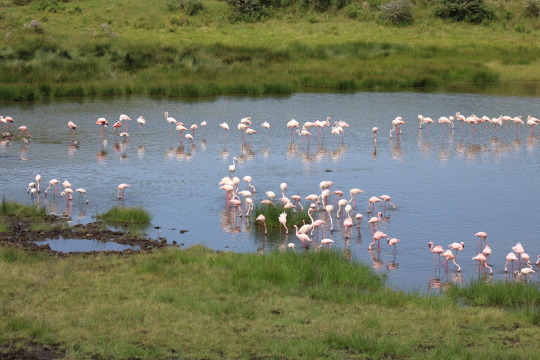
This is a flock of Greater Flamingos.




Coming in for a landing.

Crested crane. Kind of solitary birds, but beautiful when we can see them.

Female Warthog with babies that only a mother could love. We saw many babies over the next week.
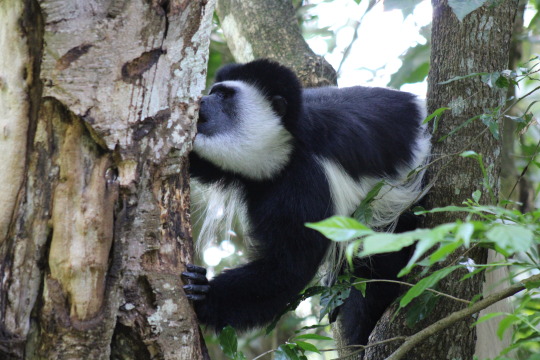
This is the rare Black-and-white Colobus Monkey. Besides being extremely beautiful they are known as the four-finger monkey since they do not have a thumb.
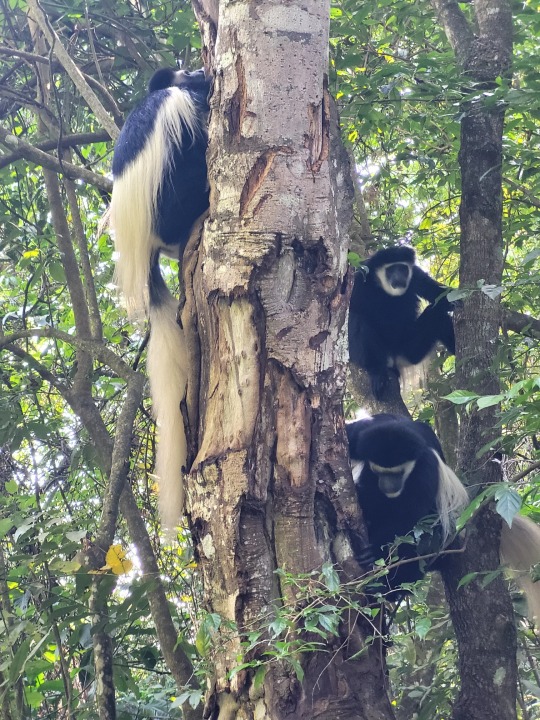
With a tail and coat like that, you can see why people collected their skins.

A baby baboon suckling it's mom.

When baboon babies are this small they travel underneath of the mom while she travels on all fours. Once they are big enough and fast enough that the eagles will not snatch them. They ride on top of the mother like a jockey.

Before you even see elephants you can smell where they have been. Smells like a barnyard. Several trees rely on elephants to plant their seeds far and wide. The husk on the seed only starts to break down in the gut of the elephant. Nice having a seed starting it's life with fertilizer all around it.

Raffy, Nancy and Dana at a small museum and restroom facility in the Arusha park. Everytime the guides pass each other in the parks, they stop and exchange information on where the animals are. It is all in Swahili so we have no idea what is being said.
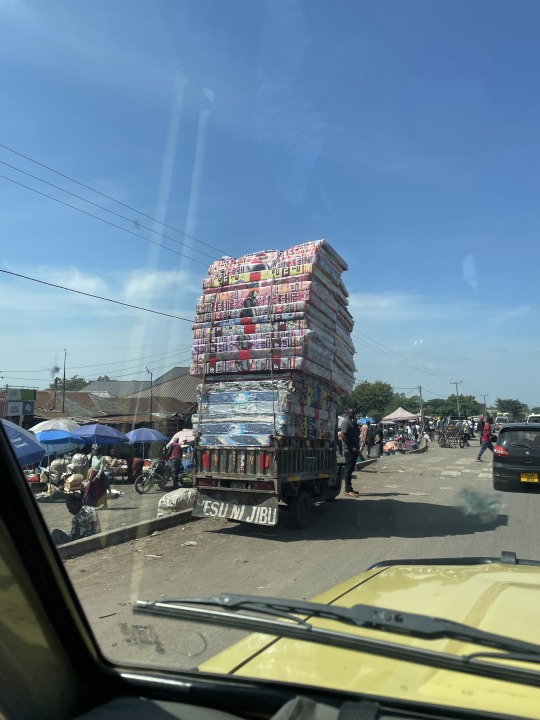

Street scenes in Arusha. Nothing gets wasted or thrown away. People walk the side of the road collecting plastic bottles for money to be recycled. Only saw one wall with graffiti.
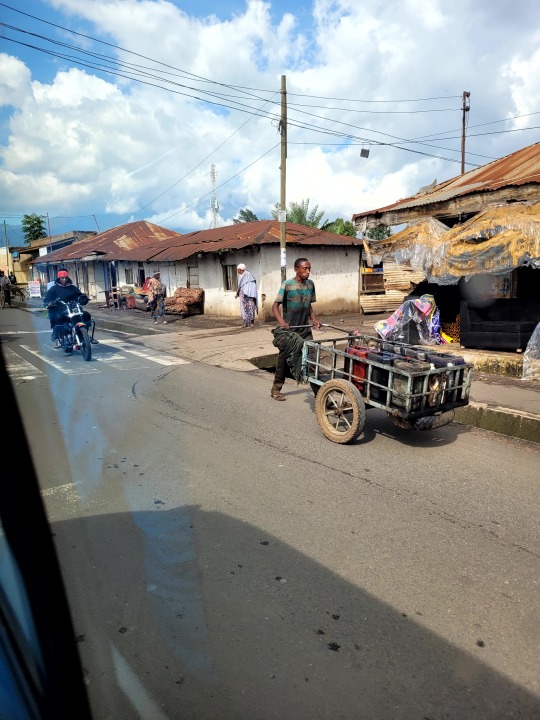



This area is a bread basket for Tanzania. The rich volcanic soil is perfect for fields of carrots, coffee, potatoes, and bananas. We saw stacks of Jackfruit and watermelon for sale.

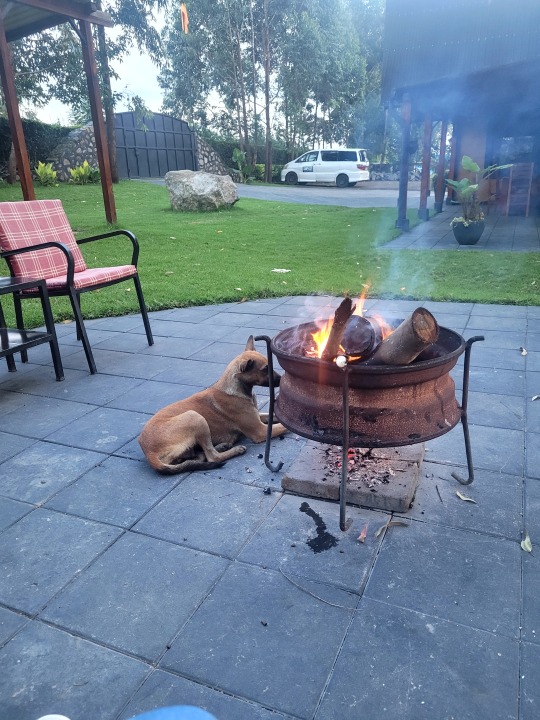
The two most popular beers here are Kilimanjaro and Safari. Ruth and Bob had arrived at Shamba Lodge while we were in the park. The next day we start our journey west.
1 note
·
View note
Text
Photo safari to Tanzania Jan. 2024, part 1
Nancy and I had a once-in-a-lifetime opportunity to go on a photo safari. A friend of Nancy's mentioned she was leaving in 30 days for her 30th trip to Africa. Nancy said that would be cool and her friend said “come with us.” So we did.
Ruth and Bob had been with our guide Raffy recently and he was starting his own guide service. So here we are on a 10-day safari with a new business owner who is going to pull out all the stops for his first clients. Plus Ruth is almost as knowledgeable about the birds and animals of Africa herself.

Above is Ruth, Nancy, Dana and Bob at the gateway to the Serengeti about day 7 of our adventure.
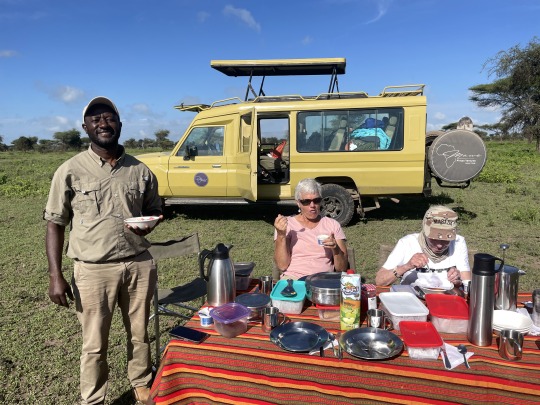
Here is Raffy, Nancy and Ruth having breakfast in the middle of the Ndutu Conservation Area. This is typical of our days. We are always the first jeep out of camp as the sun is just lightening the sky. After several hours of viewing lions, zebras, wildebeest, and gazelle. Raffy parks us in the open and we break out the breakfast provided by the camp.

Did we get to see animals up close?
You bet we saw them all, here is a tonsil check on a male lion of the Upper and Lower Marsh Pride. Hopefully, I have your attention and will start over at the beginning of the journey.
Nancy and I flew Miami-Philly-Doha, Qatar on American Airlines. Doha is about the cleanest prettiest airport in the world. Since we had a 7 hour break there and needed to get on Tanzania time. We opted for a private cubicle to sleep in. Pay by the hour, nice bunks and just what we needed. Leaving Doha at 0115 in the morning we flew 5 hours to Killamanjaro Airport (JRO) in Tanzania.

Changing of the Guard. Turns out that the Captain flying us from Miami to Philadelphia is none other than a former First Officer of mine in Miami, Brandon Lozano. On our flight was his soon-to-be in-laws, Dawn and Mike. We have to get back quickly from this journey since we are invited to Brandon and Jackie’s wedding in Key Largo. Super smooth flight, Capt. thanks for the ride!


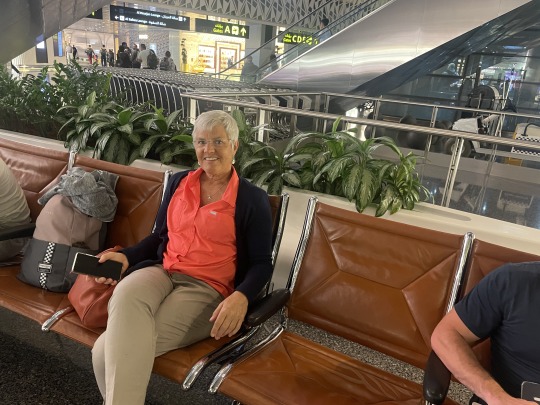
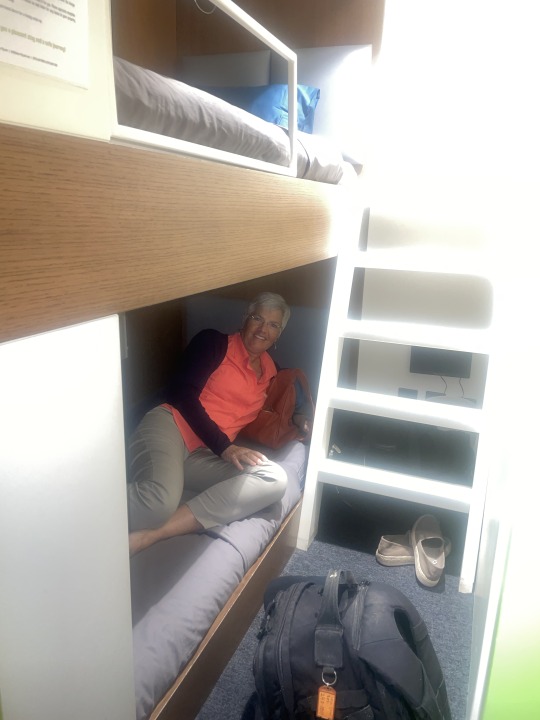
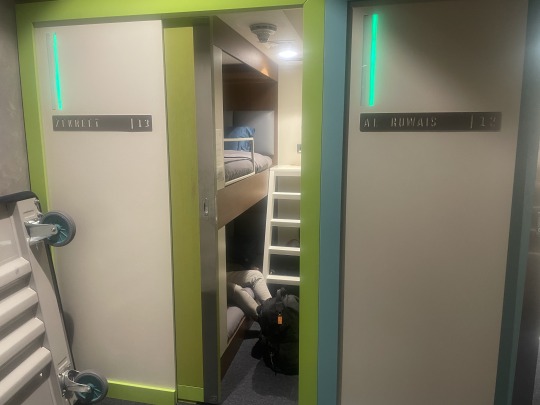
Doha airport and Nancy in our “Sleep N’ Fly” bunk room.
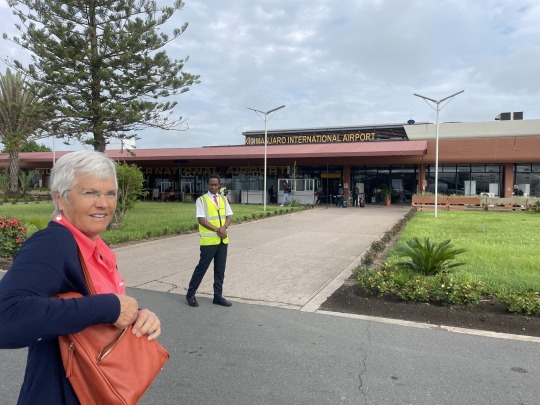
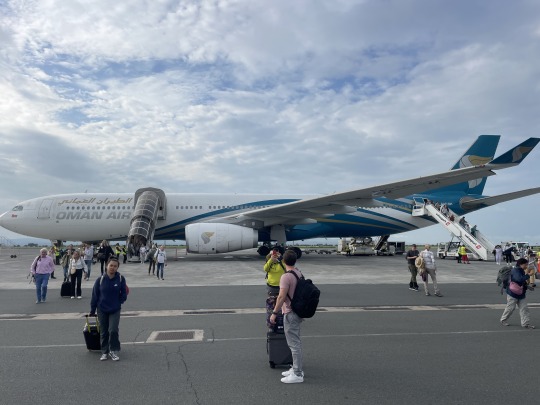
Kilimanjaro Airport and Qatar aircraft we arrived on. My visa had been approved prior to the trip but Nancy’s had not. Turned out not to be a big deal, and they allowed her in the country. Everyone we met in Tanzania could not have been nicer, starting with the Customs and Immigration officials. This country knows their future lies with tourism. Every person we met including all the camp staff, asked us to tell our friends about Tanzania and to come back soon.
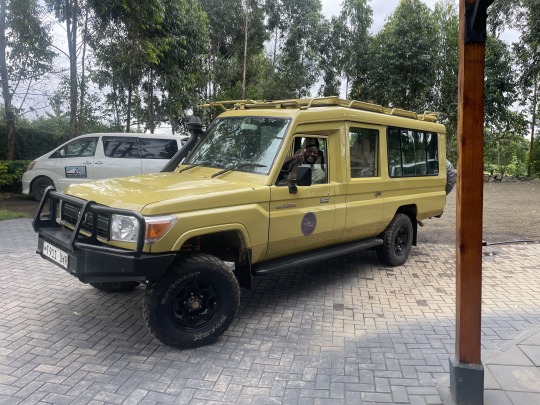
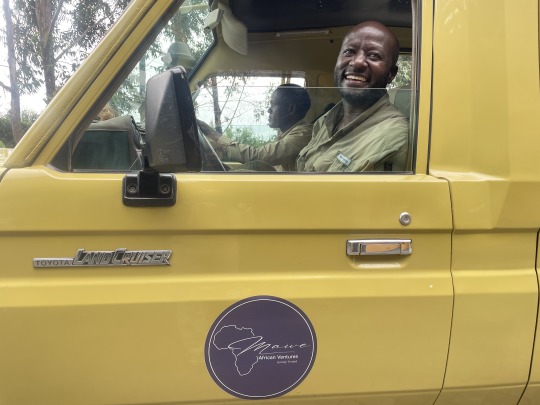
This is “Simba” a 10-year-old 300,000-mile 4-wheel drive Toyota Jeep Land Cruiser. Raffy and John met us at the airport and drove us to our first lodge, Shamba. We were the only guests at the five-cabin lodge. Outstanding staff and great food. “Simba” is Swahili for Elephant.
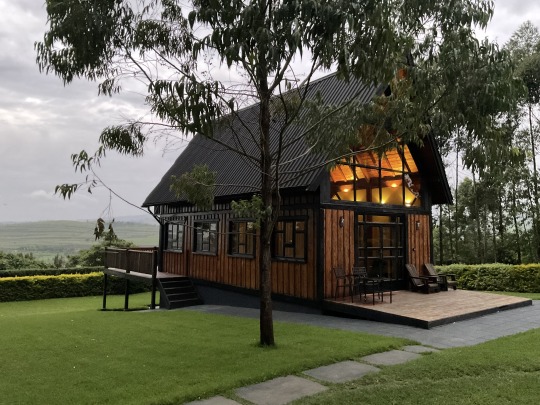
This cabin has a loft with a huge bed upstairs, bath and kitchen downstairs.

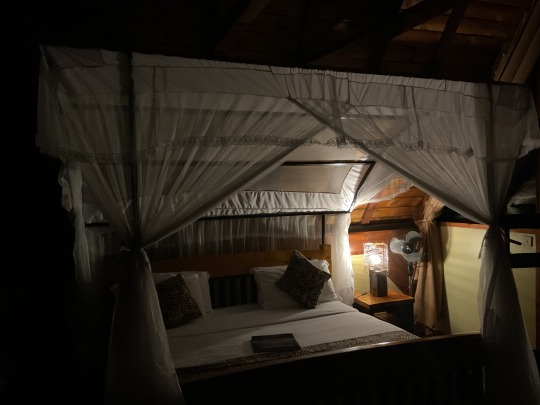
Mosquito nets surrounding the beds is standard in Africa. Even though there very heavy rains the weeks before we arrived, we only had one or two mosquito bites.
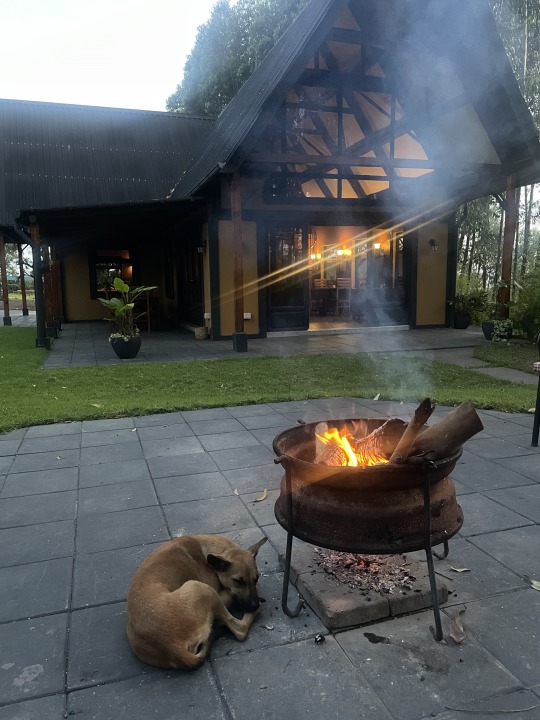
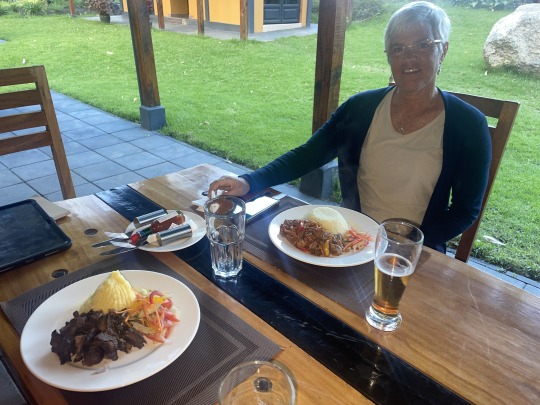
Sitting by the “Camp TV” in the evenings as it chilled down. Nancy at dinner.
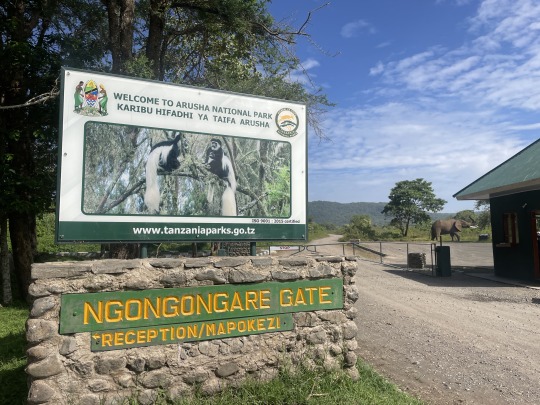
While we waited for Ruth and Bob to arrive in Arusha, Tanzania. We spent one day with Raffy in Arusha National Park. This was going to be our appetizer for the parks. A small park but it did have a monkey we would not see in any other park. So we got to see our first giraffe, elephant, zebras and baboons.

Once into the park, Raffy took a side road through the heavy woods. It was a road less traveled. Which is Raffy’s style. We ran across several giraffes which made the entire safari worthwhile in Nancy’s eyes. Things would only get better. The only giraffe in Tanzania is the Masai Giraffe.
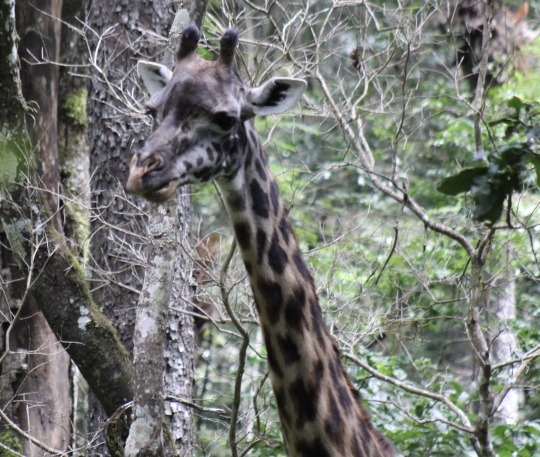

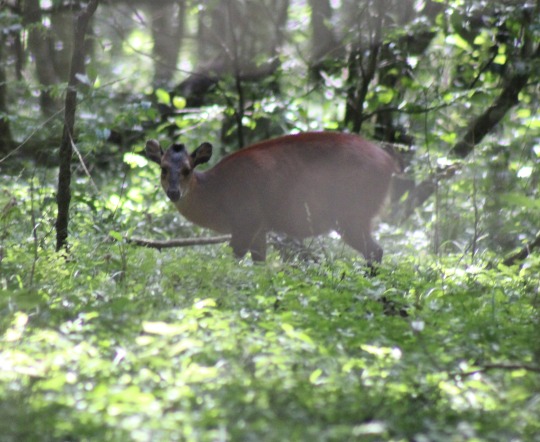
Above is a very elusive “Harvey’s Red Duiker”, which is a very small deer. We saw a couple and were lucky to get this photo. I think they get the prize for the homeliest-looking deer.


This is the seventh-highest mountain in Africa, Mt. Meru at 14,980 ft. It is inside the park. Many hikers spend three days hiking up to the summit. Each group of hikers is required to have 2 armed Rangers to protect them from predators.
Above Nancy is standing up in the jeep and taking photos. Tremendous viewing with the top raised.
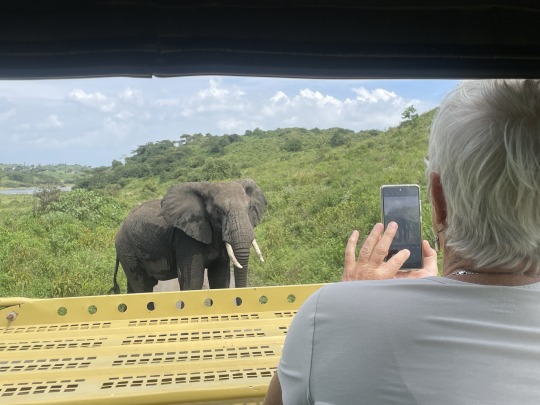
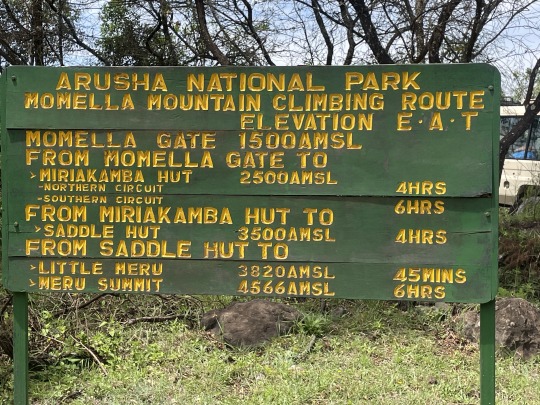
Nancy face to face with her first of many elephants. This is an older male. He was a half mile behind a female with a juvenile. Elephants have 7 sets of teeth. They wear each of the sets out in about 10 years. This guy was probably on his last set. He was not in great shape. You may have heard about elephant graveyards. Where there are multiple elephant skeletons. These graveyards are in the easiest food-gathering places for elephants that have lost their teeth. Once they lose their teeth they basically starve to death.

This is our lunch break at a park site, that provides picnic tables and restrooms. Armed park rangers are nearby and ready to escort hikers to the top of the Mt. Meru.

This is life in a third-world country. Using gravity, not much to break; just saying….
Out of permitted photos. check out part 2. above.
If you are interested in your own African Safari, check out Raffy’s website: https://maweafricanventure.com
3 notes
·
View notes
Text
2023 Bahama Cruise, Part 31 FINAL Home 0n May 23.

We “crossed our wake” on Tuesday May 23. Approximately 1,100 miles in the Bahamas. Nancy is pulling down the Bahama Courtesy flag we were required to fly in the Bahama waters. These flag are completely worn out after 2-3 months. Hard to buy well made flags.
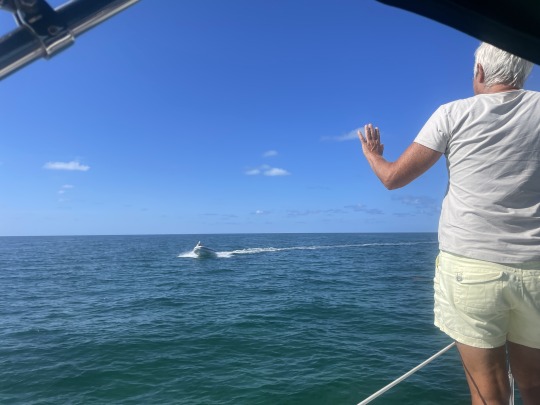

Lars was in town and came out by dinghy to greet us a couple of miles from home.

This is a rough plot of our route through the Bahamas.
Didn’t know what to clean or do first, after being gone for three months. Started in on a mound of mail our neighbors picked up for us daily. Thank you very much Lanny and Kay!
Nancy stripped the boat of things to be washed. She had a pile of laundry knee high down the whole hallway. She did give the washer and dryer some down time overnight. I hear it going again in the morning.
Just like last year, I had to jump the battery to get my truck to start. Last year rats built a nest under the hood. Drove it to the hardware store and saw a rat jump out and run away. Went to the banks drive through today. Watched to see if any rats jumped ship.
Taking a real shower and not just hanging off the back of the boat in the current was very nice.
Huge thunderstorm came over the house last night. Didn’t have to go on deck and close any hatches while half asleep. That was nice as well.
Still have sea legs 24 hours after getting off of the boat.
Lars will be getting his 34’ PDQ powercat out of the boat yard this week. Looks like I will be gang pressed as crew heading north from our house to Annapolis, Maryland. Of course there is the beginnings of a Tropical depression off the NE coast of Florida heading up the coast about that time. Memorial Day weekend on the water in South Florida is always a nightmare.
But we are back home and adjusting well.
Thanks for traveling along with us. Looks like I will still be posting some blogs on Tumblr, going up the East Coast. So if you are not interested disregard any further notifications from Tumblr.


I will leave you with one last shot of Nancy enjoying sailing in the Bahamas. It obviously agrees with her.
I do think the Dry Tortugas is calling……do you hear it?
0 notes
Text
2023 Bahama Cruise. Part 30. May 18. Current Cut, Spanish Wells, Royal Island, Eleuthera. Berry Islands.

The photo above is Nancy as the “Dinghy Commander” driving by the docks at Spanish Wells. “Dinghy Commander” gets to drive the boat. Pick the direction to hit the waves. The speed to hit the waves. Wether or not everyone gets wet or stay dry. They also have to bail the dinghy out as soon as they get in. Plus have to start the engine with the starter cord. Sometimes it starts on the first pull. Sometimes you pull the starter rope twenty times and change arms in between.
We left Hatchet Bay at daybreak, to make it through Current Cut with a minimum of current, planning on a transit of 1230. We slowed down by furling the jib. Then we slow down some more. We hit Current Cut a couple of minutes early. I would prefer to have the 1 knot ebb current (in our favor) than an 8 knot current in our face. It worked out pretty well using Nassau tides I wanted to transit 1 hour 15 minutes after Nassau. Which I did at 1230 on the dot. Since this is also a wind driven current. I had a 1 kt. current pushing we through. Could have gone through at 1 hour 30 minutes, I will plan on that next time.


Here is the Current Cut from deck level, this is the Bug-a-Boo of cuts.

This is “Current Pride” docked in the middle of the cut!



This is part of the fishing fleet at Spanish Wells. If you have eaten at a Red Lobster the lobster was probably caught by the guys at Spanish Wells. They catch 75% of all the Lobster in the Bahamas. I hear they put out 20,000 lobster condos each year. Three or four families will go in and and operate a boat for 2-3 weeks at a time, probably more.
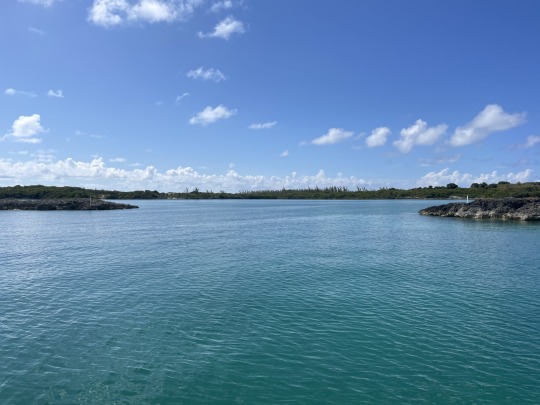
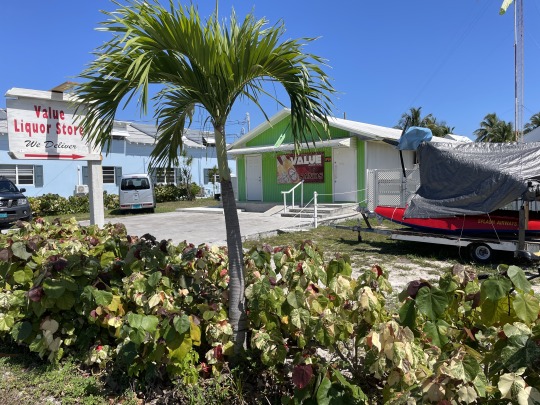
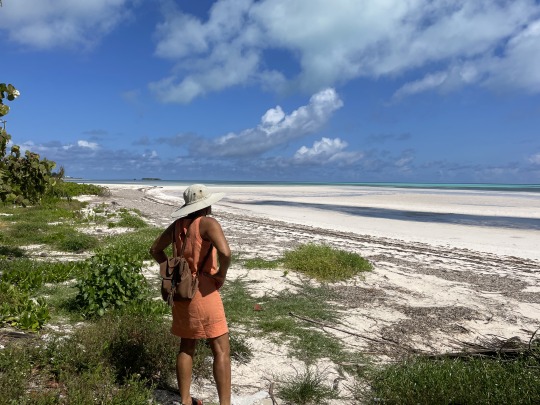
This is the cleanest settlement in the entire Bahamas. We did not see a single beer bottle or can on the side of the road. There are no half built houses. There are no old tabby built home shells with trees growing on the inside.
After a quick walk around half the town we went back to the dinghy.
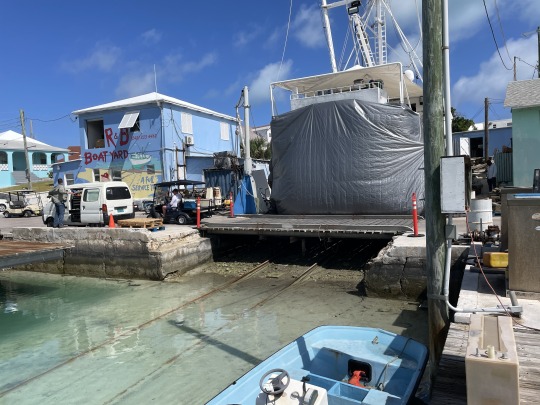

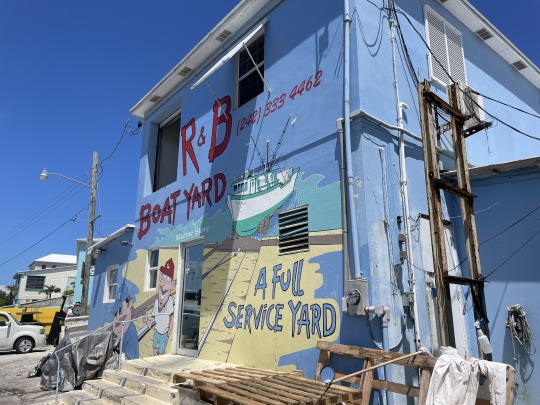
We were docked right next to the only haul out in the Bahamas. It had both a slipway dragging a fishing boat inland (top left photo) then dropping in a bridge behind it. And a lift big enough to haul out a large Catamaran (top right).

We left Spanish Wells and sailed west towards our jumping off anchorage the next morning. The winds were almost nonexistent. We sailed at a leisurely 1-2 knots. Meaning you would have walked to the corner and had to wait 10 minutes on us to get there.
Hey! We didn’t burn any diesel. And we still got there in time. You know you are in the slow lane of life when you can sail that slow and joke about it.
We turned on the engine and motored inside of Royal Island Harbor, just to check it out for future wind events. There was one monohull sailboat anchored inside. It was named “Serenity”, no way I could anchor in his harbor and disrupt his serenity. We quickly exited, turning right to West. Anchoring amongst the other sailboats waiting for a crossing in the morning.

This is Royal Island. We anchored just west of the resort. Nancy swam the anchor and then a coral head behind us. She comes back asking for the pole spear, because there are 3 invasive Lion Fish on the coral head.

Nancy is bringing back the Lion Fish she speared. Holding the Lion fish out of the water, so it does not attract sharks with the vibrations of its death. She calmly swims back to the boat and gives me the fish, before going back for more. I guess the others took a lesson from that and left.

Sunrise over Royal Island, up anchor and away! 50 mile day to the Berry Islands. The catamarans slept in because they are fast enough to make it before sunset.

Easy passage. Winds off our port quarter all day. Flying the mainsail and jib till noon. Then dosed the jib. Yeah, we motor sailed 11 hours. But it was a smooth crossing. Some sargassum weed not much. Waiting to see how much we will see in the Gulf Stream. This year is one of the worst years on record for sargassum weed.
Wednesday afternoon we pulled into the lee of Soldier Cay, next to two motor boats.
While I did 3 hours of water making on Thursday. Nancy swam to shore. After walking the small beach she snorkeled back to the boat.
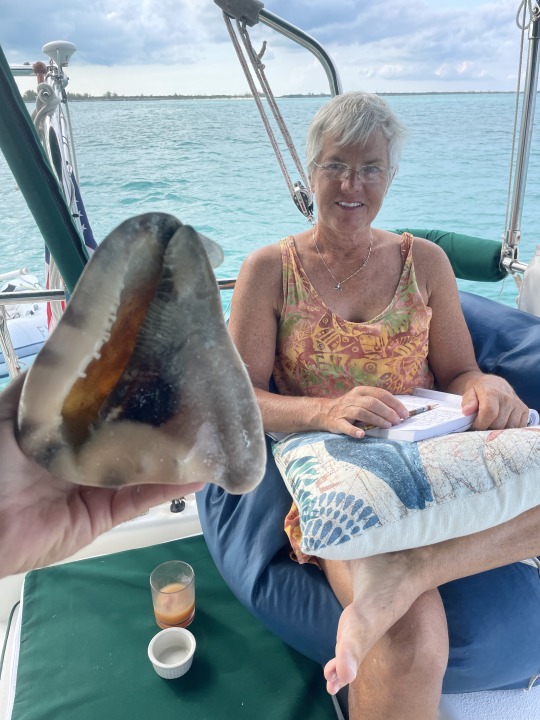
This is the mature King Helmet shell (Cassis tuberosa) she found. We never take live shells, only dead ones. This will clean up nice with a little muriatic acid. A shark followed her a ways back to the boat. She figured she may have to bop the shark on the nose with the shell. Don’t mess with her when she has a prize shell! She is thinking afterwards that it was a Lemon Shark. Definitely not a Bull shark. The Bulls account for more shark attacks in the Bahamas than any other shark.

We moved due west to the east side of Ambergris Cay. There the waves eased up and we put the engine on the dinghy. Then we motored to the south end of Ambergris Cay and anchored. We proceeded during low tide to walk and beach comb south. Wading across a small creek to Money Cay. Here there were many chunks of coal from a nearby wreck. We took several photos along the way.
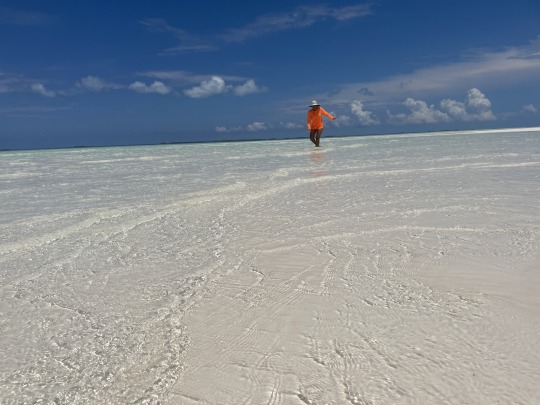
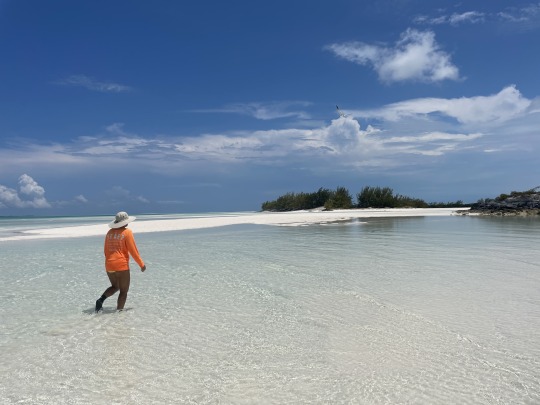

Creek separating Ambergris Cay from Money Cay.
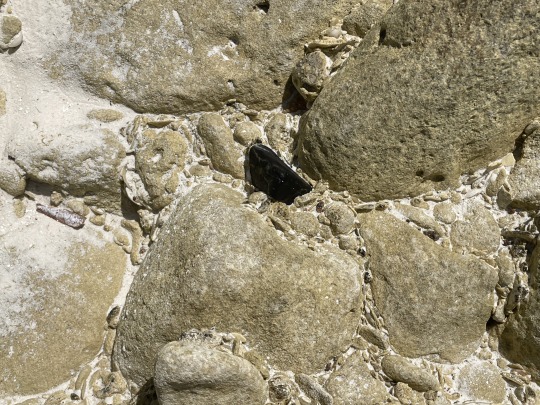
The black item is a piece of coal from a nearby wreck. Only on Money Cay did we see these embedded in the rocks. The wreck should be nearby. Plus there were many bottles. Maybe a couple were were from the wreck. Most were not that old.

Nancy chilling for a bit at low tide.

Only ones for miles of beach at low tide. I think we will stay another day.

Nancy with her beach combing finds.
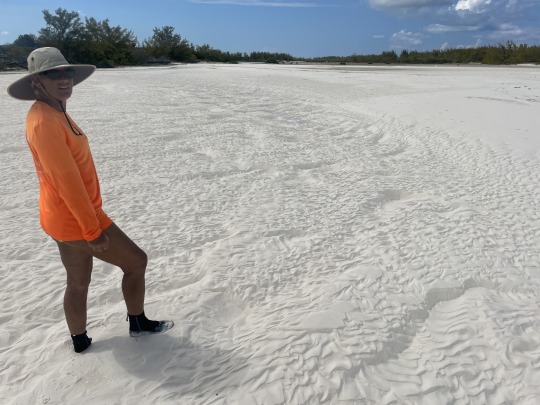
Mother Natures sand art.

Here are the treasures of the day beach combing. Auger shells are the long orange shells. The biggest shell is a Milk Conch. The prize of the day was the white shell at the bottom left of the photo. It is in the Scotch Bonnet family of shells. The bottles may very well have come from the wreck off shore.
We planned on doing more beach combing and dinghy rides through the cuts the next day. When we woke up the seas had picked up. After breakfast, we decided to motor counter clockwise around the the Berry Islands and head to the lee of Great Harbor. That took 5 hours. Just after a fierce storm blew through we headed in by dinghy to get 15 gallons of diesel. Hector was kind enough to stay open a couple of minutes after four and top off our jerry jugs.
We are now set for the final push home on Saturday. We will anchor on the Bahama Bank about 20 miles closer to home on Saturday night. Sunday we will move the rest of the way across the shallow Bahama Bank and anchor up near South Riding Rock. Either Monday or Tuesday, both look like easy motor sailing days crossing of the Gulf Stream. Our Bahama Cruise 2023 is winding down.
During the next 3 days will be off the grid, no internet, no weather updates. Wish us well!
S/V Sea Breeze
1 note
·
View note
Text
2023 Bahama Cruise, Part 29. May 14. Hatchet bay, Eleuthera.

Nancy walking two miles back to town after snorkeling with the seahorses on Mother’s Day. Still smiling after another tour that can not be found in the tour pamphlets.

We anchored on Saturday evening with threats of storms over night and Sunday. Never got rained on. We are anchored in “Hatchet Bay” on the right side of the photo. Sweetings Pond with the Seahorses is the pond on the left of the photo.

After taking our trash to town. We walked around the town on Mother’s Day, Sunday morning. Things are quiet on Sunday mornings in the settlements. We walked up to the Queen’s Highway and turned east or left.
A driver stopped his car and talked to us. He was the owner of the restaurant where everyone, including us, parks their dinghy. The sign above the trash barrel was pay $3 in the office. The office was closed. When this guy introduced himself, he said he owned the restaurant. So we paid this guy our $3 for one bag of trash. He also offered to drive us to the Sweetings Pond Seahorse Preserve for $20.
We enjoy our walks and declined the offer. After we were half way to the pond. A guy stopped in his pick up truck and offered us a ride. So Nancy and I jumped in the back of his pick up truck. Looking at the boxes of roofing nails in the bed of the truck, we assumed he was a roofer. After he pulled off across from the dirt road to the pond. We bailed out of the back of the truck and thanked him. With typical Bahama out island hospitality. He said, “That is why we are here, to help you out”. This guy was a Roofer, not a person in the tourism hospitality trade. But a genuine out island person always willing to help. Just about every Bahamian owned car honks or waves. The rental cars have a different license plate. Don’t expect a honk or way from them.

This is the dirt road leading to Sweetings Pond. Good enough for a rental car, but not good enough for your personal car.

This is a proposed Preserve. The water is probably a bit more saline than the ocean and accounted for us floating so high in the water.

With our sandals and footwear, versus fins, per the rules. We had a bit of a time getting to the bottom to see the seahorses up close.

This pond was cut off from the open sea 6,000 years ago. The level changes with each tidal change. But the visibility is poor.
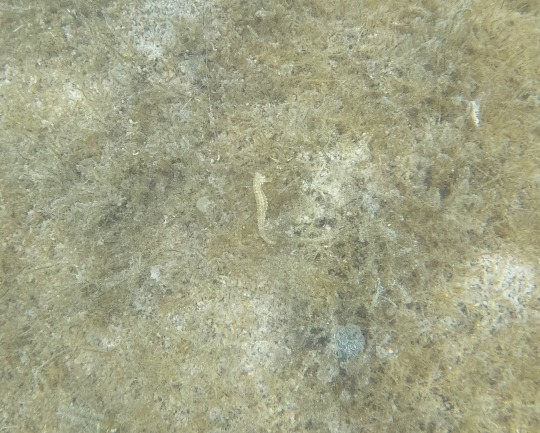
This is a Lined Seahorse (Hippocampus erectus). They are considered a “Vulnerable species”. These were not as obvious or as plentiful as we were led to believe. They were in the grass and usually head down foraging. This is probably a female, note the lack of the belly pouch.

You can just barely see the eye on this seahorse. Judging by the belly this is very possible a pregnant Male Seahorse. Who knew that “woke” seahorses where leading the way of males becoming pregnant? Actually the female becomes pregnant and then sends the eggs over to the male that raises them in his brood pouch.

The more interesting organism in the pond were the multitude of nudibranchs. Specifically Fringeback Dondice (Dondice occidentalis) They were everywhere and working along the top of the grass. Much more prolific than the seahorses.

Since my photo was so bad, I stole this off the internet.

This is the bright red file clam (Ctenoides Scraba) that was very abundant in the pond.

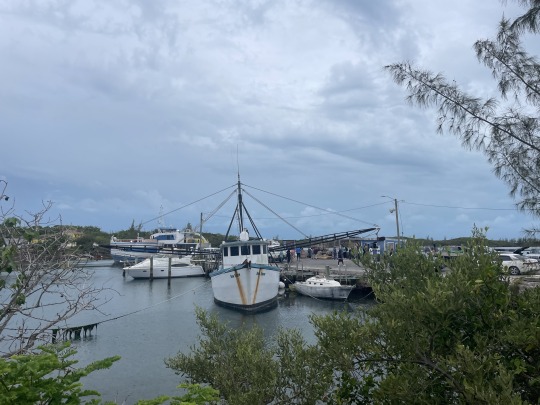
After walking back to town we saw that the car ferry from Nassau was in town. Top left photo has cars backing up onto the ferry.

The pigs in a trailer, are they coming or going, who knows? Can they swim? If they can’t swim, will we see them at dinner?
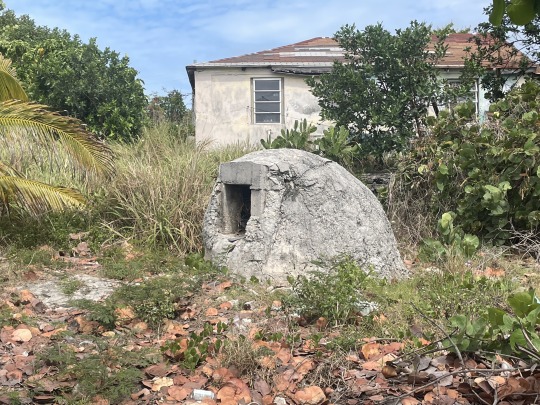
This apparently is a communal cooking bread oven of days before. Makes sense, stays hot for hours, using less fuel than each house cooking bread in their private oven.
Next we pull anchor and head 16 miles west for the infamous “Current Cut”. You have to time it for 1+15 to 1+30 minutes after the tide change in Nassau. If we hit it wrong, we may be fighting a 6-8 kt. current in a boat that only goes 6 knots.
S/V Sea Breeze, Hatchet Pond, Eleuthera Island Bahama
4 notes
·
View notes
Text
2023 Bahama Cruise, Part 28. May 12 Governors Harbor, Alabaster Beach, Eleuthera.

This is the chart blow up of Governors Harbor, to give you an idea of the area. Against advice on the chart and our friends who were here a couple of days earlier. We anchored inside the harbor. Our anchor dug in well, and we recklessly never dove it.

After a quick trip to the grocery store for a dozen eggs and another bottle of Coconut Rum. We walked around the harbor shore line. We visited the old cemetery near the water. It was well kept with some very old Grave Stones. Behind the cemetery was the St. Patrick’s Anglican Church, built in 1848.

Just around the corner from the church was this beautiful building. It is the “Haynes Library” built much later in 1897. Notice the huge concrete buttresses at the corners, facing 45 degrees from the building. The ones in the back go almost all the way up the second floor. This library was built to withstand a Hurricane. Hurricane Andrew came nearby in 1992 as a Category 3 Hurricane.

Cupid’s Cay makes the outer hook of the harbor. Not sure if it was a separate Cay originally or not as the name would suggest. But today it is connected to the mainland by a substantial causeway. Cupid’s Cay was the home of the first Bahama Parliament in 1736.

On Cupid’s Cay was the first U.S. Consulate to the Bahamas in 1789.
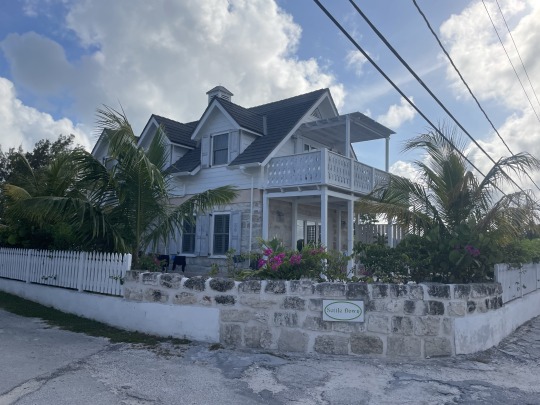
This is a hotel rental on the Cupid’s Cay. This reminds us of old Key West. We walked back to the dinghy and then moved to the boat for the night.
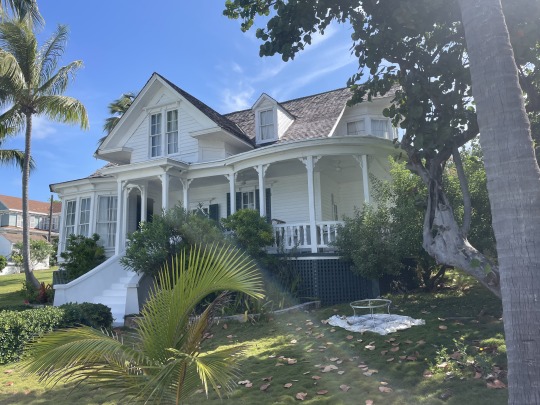
The next morning we did a quick walk through the better part of town. These were well kept up old houses that you can rent. Grounds were green with landscaping and well kept. Really reminds us of Old Key West.

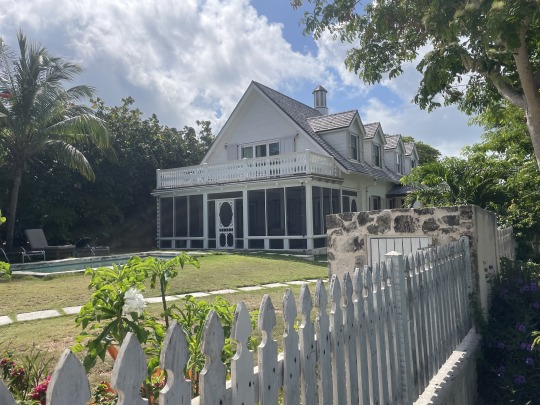
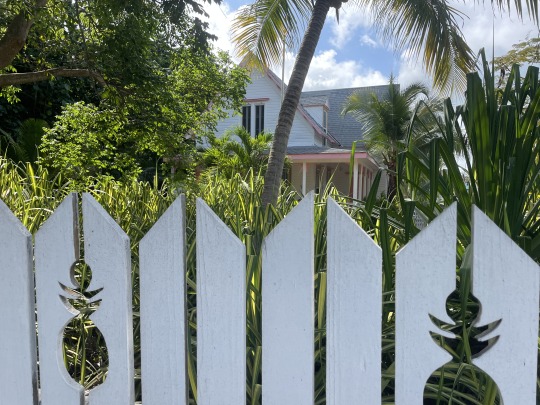


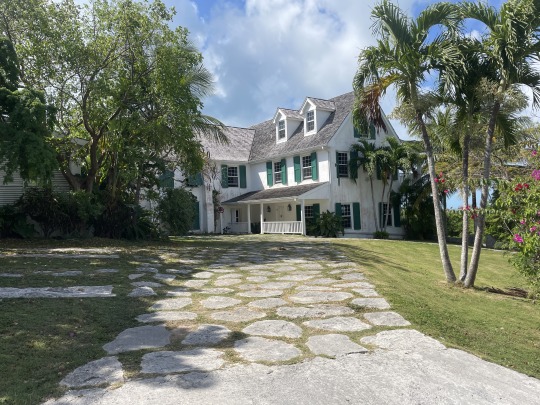

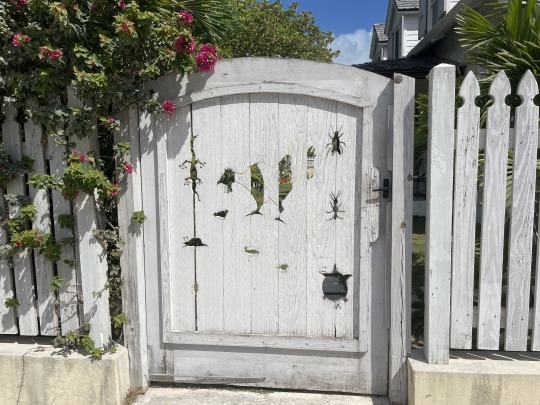
This walk took us over the top of the ridge about 142 ft. high. The ends up going through a carved out are to keep it from being so steep. There was an cement cistern reservoir at the top to supply water pressure to the neighborhood.


From the top we could see both coast of the island. Once we finished this short walk it was back to the boat and move anchorages. Governors Harbor left a good impression with us. Part of it was like most of the settlements. Parts were going high class rentals. Lots of history in this town.



As always the few people we met were very nice and friendly. Apparently there are no snakes on this Island. The chickens and rosters have run amuck. The crowing starts early and is continuous for hours before daybreak.
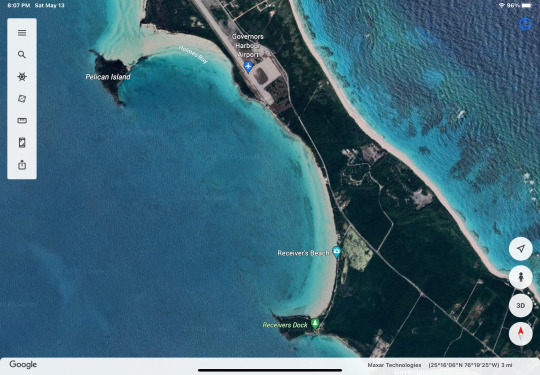
This is Alabaster Bay. It is 6 miles north of Governors Harbor.
On Monday 13th, we hike 3.7 miles round trip. First across the island to the abandoned US Navy Base. Right turn and a 1 mile plus hike down the beach. Lunch at “The Deck” then continuing clockwise out to the Queen’s Highway and home.
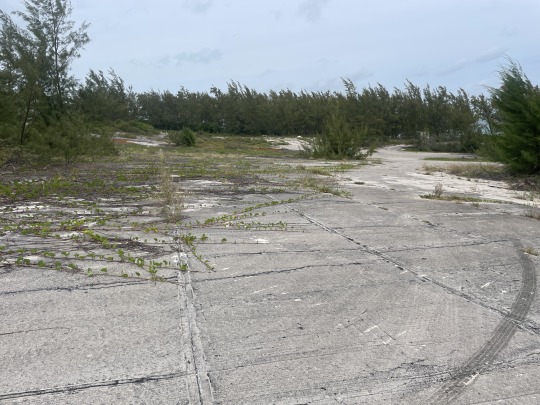
In 1950 this USNavy Base was started as an experimental SOSUS (Sound Surveillance System) having 6 hydrophones deployed off shore. Then in 1958 it became a missile tracking site for US missiles launched from Cape Canaveral. Typical of USNavy bases on islands, they concrete the sides of hills to catch the rain water at the bottom. See photo above, there were several of these. The base was closed in 1982. During its tenure, usually only the Base Commander was actually in the military. The other personnel worked either for Pan American Airways (Pan Am) or Radio Corporation of America (RCA).
In 1957 the base became the Eleuthera Auxiliary Air Force Base (AAFB).

Being a sailor I can’t help but drag a large clump of net and floats up to the high tide mark. It would be a nightmare if you fouled your prop in the open ocean with something like this.

This is “The Deck”. A bar and grill on the oceanside. It is owned by Mark Robert a descendent of the original settlers at Hope Town Abaco.
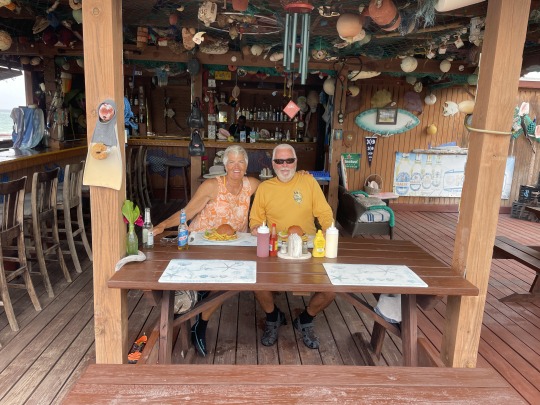
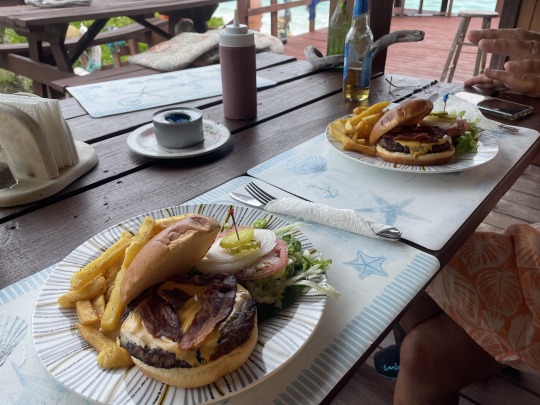
Bacon Cheese Burgers in Paradise. We learned a new trick. When flies are giving you a problem, light a can of sterno. Even after you put it out they stay away for several minutes.

This is all the treasure we collected on the beach. The most prized of the different sea beans, is the “Hamburger bean” (front left).
It was a slow hike back to the boat after the huge lunch. Nancy cut my hair and beard. After a short recovery time from the lunch. We pulled anchor and sailed north to Hatchet Bay. We tried to out run some storms coming up from the south. Didn’t work out so well.
Using Standard WaterTribe rules. We reefed early. If reefing even enters your mind, then you should go ahead and reef (pull in) your sails. Since we did, the gust from the storm never materialized.
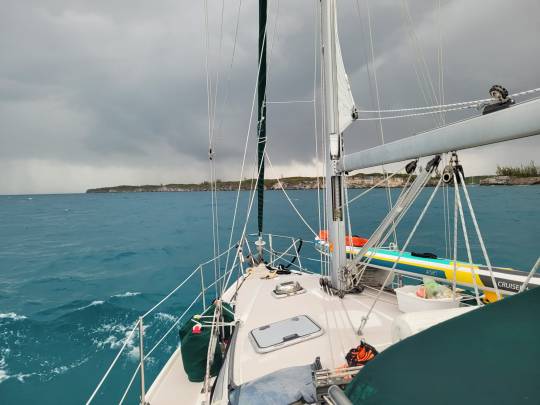
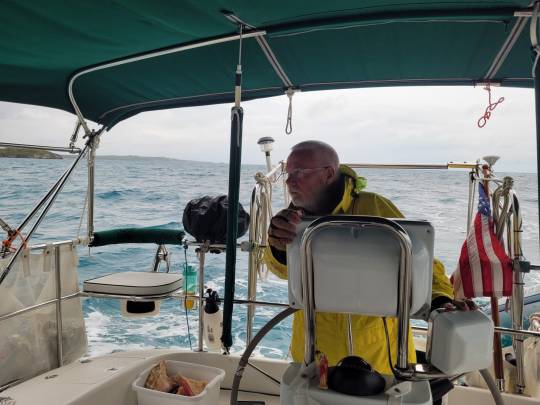
This very well could be a hairy entrance., it is 80 ft. wide and has rock cliffs. Large amount of current to get in and out of this small cut. We had 2 ft. swells and 12-15 kt. winds.
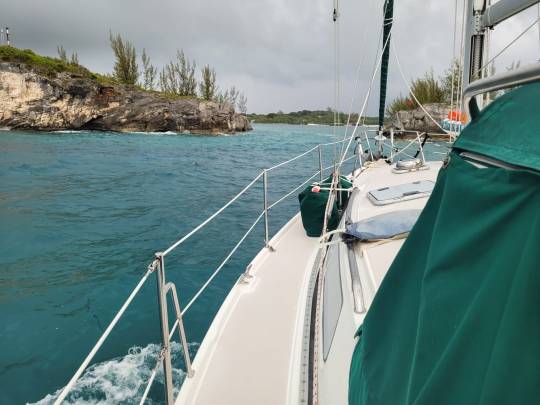
We came into the bay and put out a “Security call” on VHF announcing our entry into the bay. The mailboats and car ferries never say when they are approaching or exiting the harbor. We assume they have a VHF, but they seldom ever answer.
We entered during the top of the flood tide, so no current was evident. We put our anchor down in the north end of the harbor. Only 8 cruisers here. Three left the next morning.
S/V Sea Breeze, Alabaster Bay, Eleuthera, Bahamas.
4 notes
·
View notes